Business Incubators in Saudi Arabia VS International Incubator Case study
VerifiedAdded on 2021/09/14
|18
|7337
|37
AI Summary
Contribute Materials
Your contribution can guide someone’s learning journey. Share your
documents today.
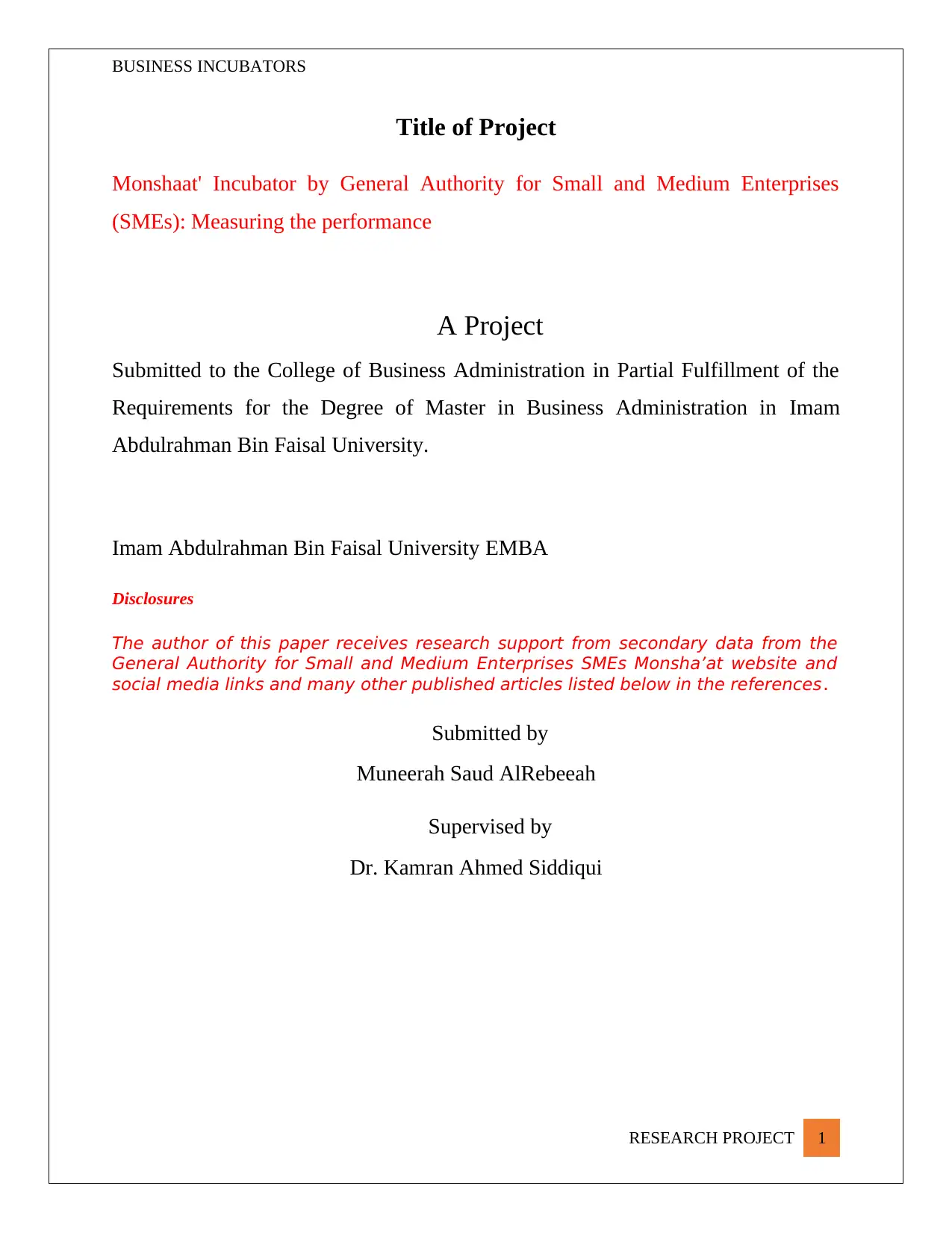
BUSINESS INCUBATORS
Title of Project
Monshaat' Incubator by General Authority for Small and Medium Enterprises
(SMEs): Measuring the performance
A Project
Submitted to the College of Business Administration in Partial Fulfillment of the
Requirements for the Degree of Master in Business Administration in Imam
Abdulrahman Bin Faisal University.
Imam Abdulrahman Bin Faisal University EMBA
Disclosures
The author of this paper receives research support from secondary data from the
General Authority for Small and Medium Enterprises SMEs Monsha’at website and
social media links and many other published articles listed below in the references.
Submitted by
Muneerah Saud AlRebeeah
Supervised by
Dr. Kamran Ahmed Siddiqui
RESEARCH PROJECT 1
Title of Project
Monshaat' Incubator by General Authority for Small and Medium Enterprises
(SMEs): Measuring the performance
A Project
Submitted to the College of Business Administration in Partial Fulfillment of the
Requirements for the Degree of Master in Business Administration in Imam
Abdulrahman Bin Faisal University.
Imam Abdulrahman Bin Faisal University EMBA
Disclosures
The author of this paper receives research support from secondary data from the
General Authority for Small and Medium Enterprises SMEs Monsha’at website and
social media links and many other published articles listed below in the references.
Submitted by
Muneerah Saud AlRebeeah
Supervised by
Dr. Kamran Ahmed Siddiqui
RESEARCH PROJECT 1
Secure Best Marks with AI Grader
Need help grading? Try our AI Grader for instant feedback on your assignments.
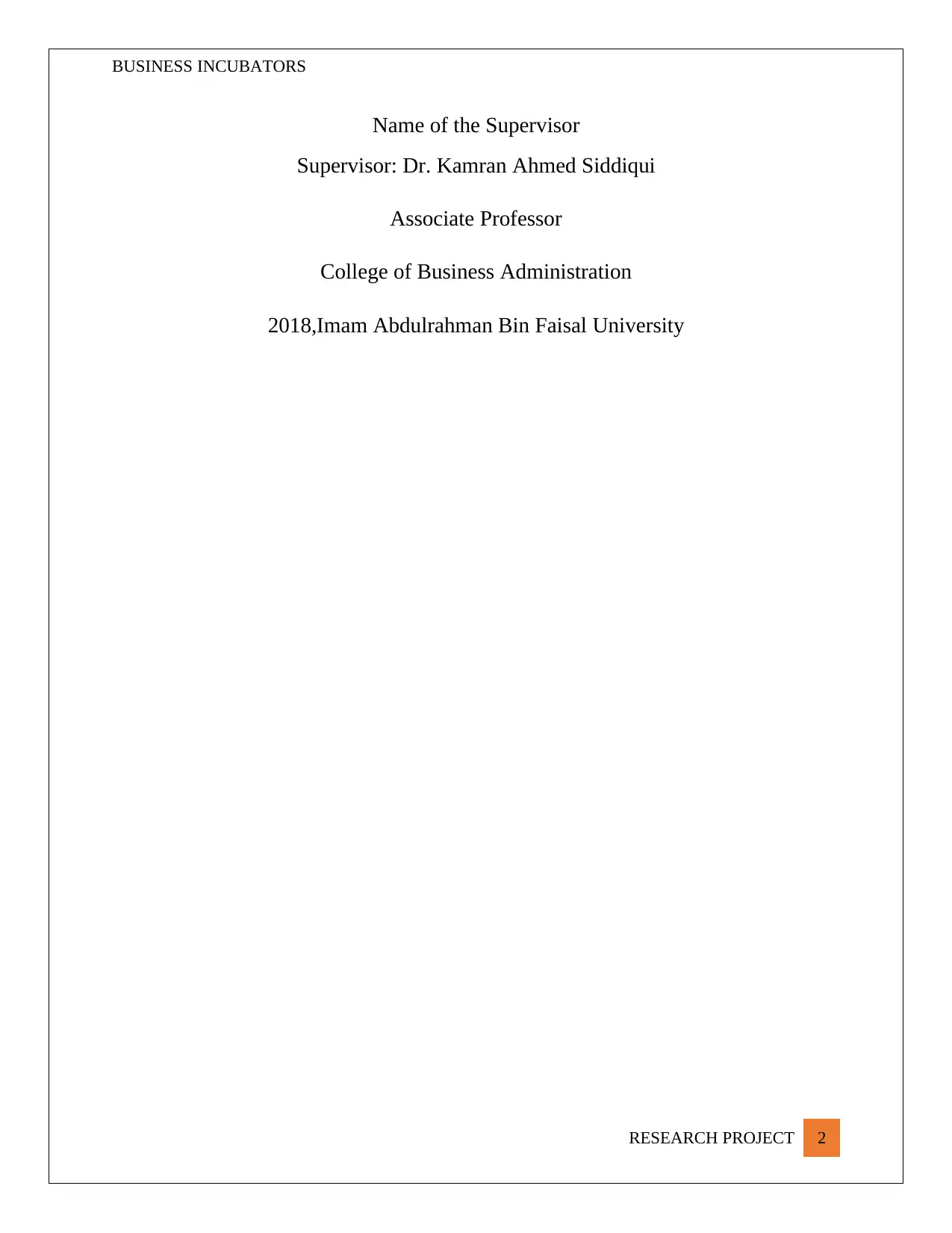
BUSINESS INCUBATORS
Name of the Supervisor
Supervisor: Dr. Kamran Ahmed Siddiqui
Associate Professor
College of Business Administration
2018,Imam Abdulrahman Bin Faisal University
RESEARCH PROJECT 2
Name of the Supervisor
Supervisor: Dr. Kamran Ahmed Siddiqui
Associate Professor
College of Business Administration
2018,Imam Abdulrahman Bin Faisal University
RESEARCH PROJECT 2
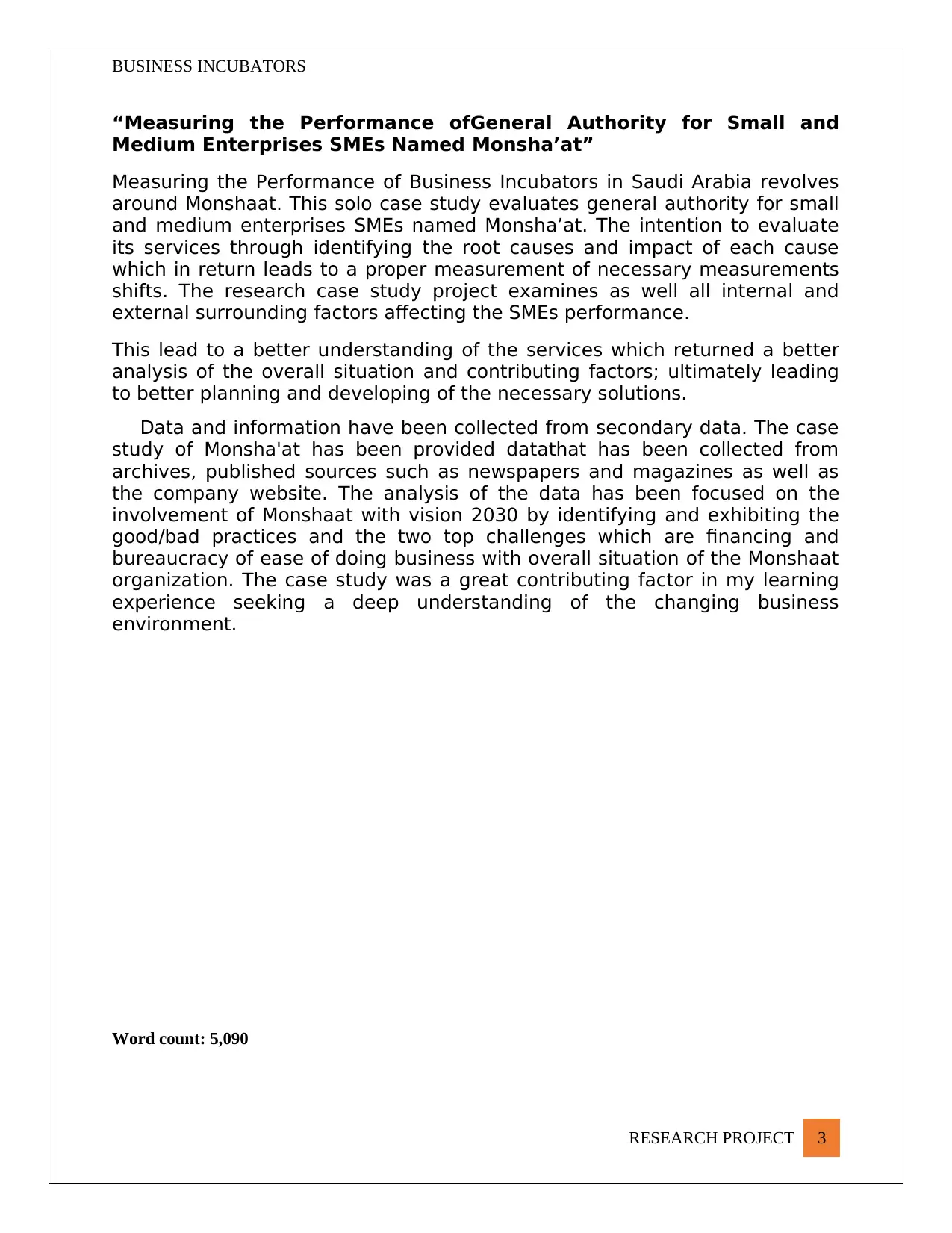
BUSINESS INCUBATORS
“Measuring the Performance ofGeneral Authority for Small and
Medium Enterprises SMEs Named Monsha’at”
Measuring the Performance of Business Incubators in Saudi Arabia revolves
around Monshaat. This solo case study evaluates general authority for small
and medium enterprises SMEs named Monsha’at. The intention to evaluate
its services through identifying the root causes and impact of each cause
which in return leads to a proper measurement of necessary measurements
shifts. The research case study project examines as well all internal and
external surrounding factors affecting the SMEs performance.
This lead to a better understanding of the services which returned a better
analysis of the overall situation and contributing factors; ultimately leading
to better planning and developing of the necessary solutions.
Data and information have been collected from secondary data. The case
study of Monsha'at has been provided datathat has been collected from
archives, published sources such as newspapers and magazines as well as
the company website. The analysis of the data has been focused on the
involvement of Monshaat with vision 2030 by identifying and exhibiting the
good/bad practices and the two top challenges which are financing and
bureaucracy of ease of doing business with overall situation of the Monshaat
organization. The case study was a great contributing factor in my learning
experience seeking a deep understanding of the changing business
environment.
Word count: 5,090
RESEARCH PROJECT 3
“Measuring the Performance ofGeneral Authority for Small and
Medium Enterprises SMEs Named Monsha’at”
Measuring the Performance of Business Incubators in Saudi Arabia revolves
around Monshaat. This solo case study evaluates general authority for small
and medium enterprises SMEs named Monsha’at. The intention to evaluate
its services through identifying the root causes and impact of each cause
which in return leads to a proper measurement of necessary measurements
shifts. The research case study project examines as well all internal and
external surrounding factors affecting the SMEs performance.
This lead to a better understanding of the services which returned a better
analysis of the overall situation and contributing factors; ultimately leading
to better planning and developing of the necessary solutions.
Data and information have been collected from secondary data. The case
study of Monsha'at has been provided datathat has been collected from
archives, published sources such as newspapers and magazines as well as
the company website. The analysis of the data has been focused on the
involvement of Monshaat with vision 2030 by identifying and exhibiting the
good/bad practices and the two top challenges which are financing and
bureaucracy of ease of doing business with overall situation of the Monshaat
organization. The case study was a great contributing factor in my learning
experience seeking a deep understanding of the changing business
environment.
Word count: 5,090
RESEARCH PROJECT 3
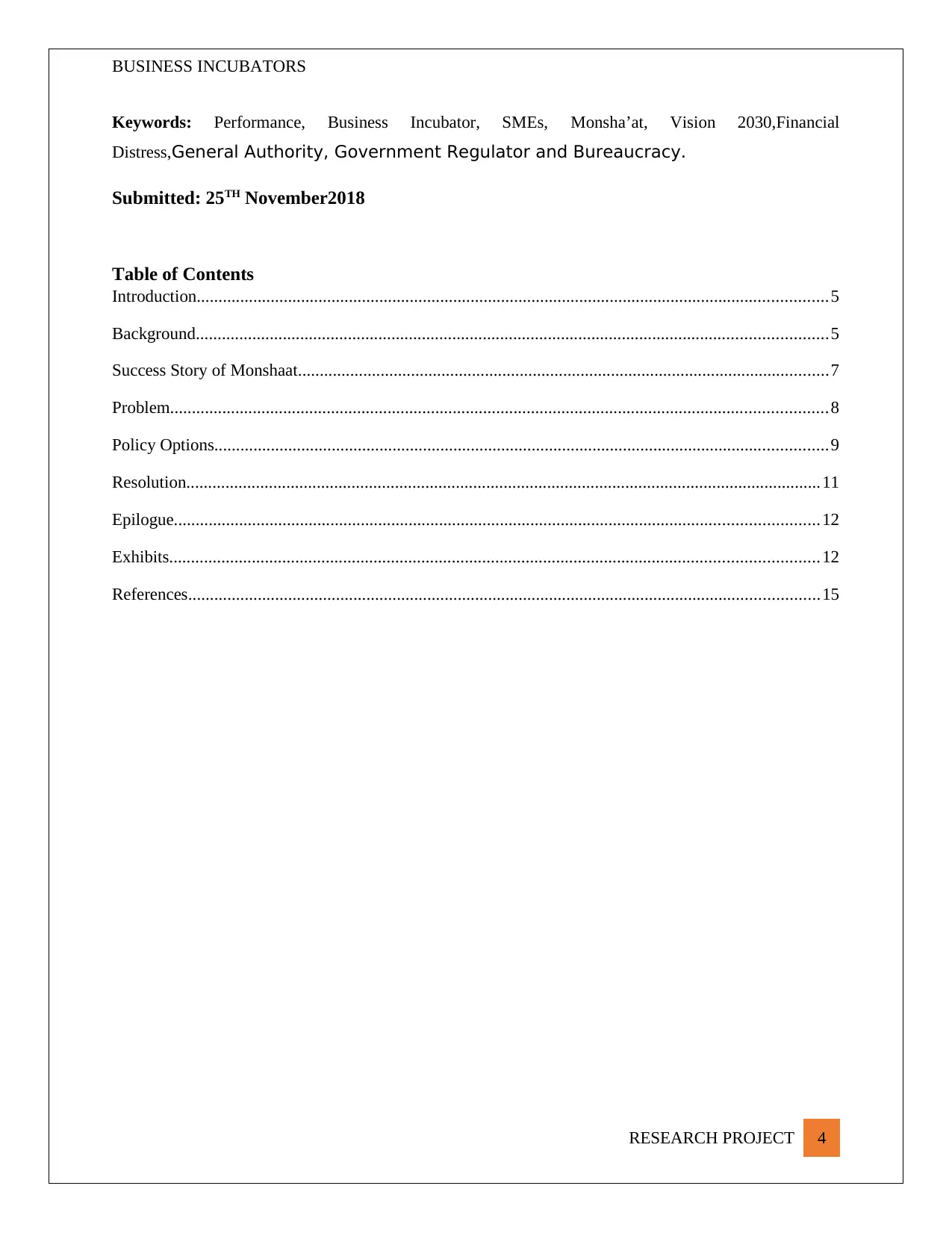
BUSINESS INCUBATORS
Keywords: Performance, Business Incubator, SMEs, Monsha’at, Vision 2030,Financial
Distress,General Authority, Government Regulator and Bureaucracy.
Submitted: 25TH November2018
Table of Contents
Introduction.................................................................................................................................................5
Background.................................................................................................................................................5
Success Story of Monshaat..........................................................................................................................7
Problem.......................................................................................................................................................8
Policy Options.............................................................................................................................................9
Resolution..................................................................................................................................................11
Epilogue....................................................................................................................................................12
Exhibits.....................................................................................................................................................12
References.................................................................................................................................................15
RESEARCH PROJECT 4
Keywords: Performance, Business Incubator, SMEs, Monsha’at, Vision 2030,Financial
Distress,General Authority, Government Regulator and Bureaucracy.
Submitted: 25TH November2018
Table of Contents
Introduction.................................................................................................................................................5
Background.................................................................................................................................................5
Success Story of Monshaat..........................................................................................................................7
Problem.......................................................................................................................................................8
Policy Options.............................................................................................................................................9
Resolution..................................................................................................................................................11
Epilogue....................................................................................................................................................12
Exhibits.....................................................................................................................................................12
References.................................................................................................................................................15
RESEARCH PROJECT 4
Secure Best Marks with AI Grader
Need help grading? Try our AI Grader for instant feedback on your assignments.
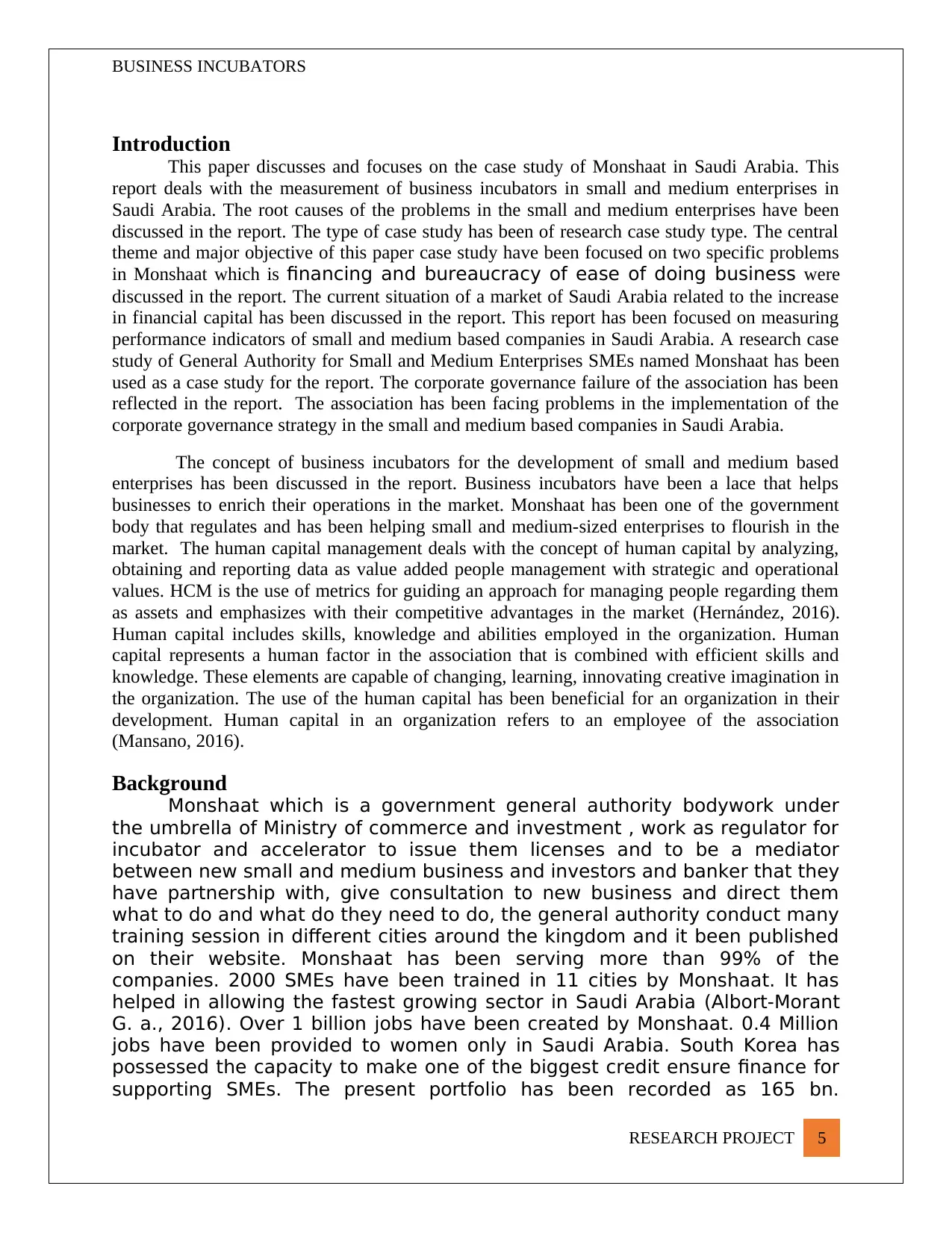
BUSINESS INCUBATORS
Introduction
This paper discusses and focuses on the case study of Monshaat in Saudi Arabia. This
report deals with the measurement of business incubators in small and medium enterprises in
Saudi Arabia. The root causes of the problems in the small and medium enterprises have been
discussed in the report. The type of case study has been of research case study type. The central
theme and major objective of this paper case study have been focused on two specific problems
in Monshaat which is financing and bureaucracy of ease of doing business were
discussed in the report. The current situation of a market of Saudi Arabia related to the increase
in financial capital has been discussed in the report. This report has been focused on measuring
performance indicators of small and medium based companies in Saudi Arabia. A research case
study of General Authority for Small and Medium Enterprises SMEs named Monshaat has been
used as a case study for the report. The corporate governance failure of the association has been
reflected in the report. The association has been facing problems in the implementation of the
corporate governance strategy in the small and medium based companies in Saudi Arabia.
The concept of business incubators for the development of small and medium based
enterprises has been discussed in the report. Business incubators have been a lace that helps
businesses to enrich their operations in the market. Monshaat has been one of the government
body that regulates and has been helping small and medium-sized enterprises to flourish in the
market. The human capital management deals with the concept of human capital by analyzing,
obtaining and reporting data as value added people management with strategic and operational
values. HCM is the use of metrics for guiding an approach for managing people regarding them
as assets and emphasizes with their competitive advantages in the market (Hernández, 2016).
Human capital includes skills, knowledge and abilities employed in the organization. Human
capital represents a human factor in the association that is combined with efficient skills and
knowledge. These elements are capable of changing, learning, innovating creative imagination in
the organization. The use of the human capital has been beneficial for an organization in their
development. Human capital in an organization refers to an employee of the association
(Mansano, 2016).
Background
Monshaat which is a government general authority bodywork under
the umbrella of Ministry of commerce and investment , work as regulator for
incubator and accelerator to issue them licenses and to be a mediator
between new small and medium business and investors and banker that they
have partnership with, give consultation to new business and direct them
what to do and what do they need to do, the general authority conduct many
training session in different cities around the kingdom and it been published
on their website. Monshaat has been serving more than 99% of the
companies. 2000 SMEs have been trained in 11 cities by Monshaat. It has
helped in allowing the fastest growing sector in Saudi Arabia (Albort-Morant
G. a., 2016). Over 1 billion jobs have been created by Monshaat. 0.4 Million
jobs have been provided to women only in Saudi Arabia. South Korea has
possessed the capacity to make one of the biggest credit ensure finance for
supporting SMEs. The present portfolio has been recorded as 165 bn.
RESEARCH PROJECT 5
Introduction
This paper discusses and focuses on the case study of Monshaat in Saudi Arabia. This
report deals with the measurement of business incubators in small and medium enterprises in
Saudi Arabia. The root causes of the problems in the small and medium enterprises have been
discussed in the report. The type of case study has been of research case study type. The central
theme and major objective of this paper case study have been focused on two specific problems
in Monshaat which is financing and bureaucracy of ease of doing business were
discussed in the report. The current situation of a market of Saudi Arabia related to the increase
in financial capital has been discussed in the report. This report has been focused on measuring
performance indicators of small and medium based companies in Saudi Arabia. A research case
study of General Authority for Small and Medium Enterprises SMEs named Monshaat has been
used as a case study for the report. The corporate governance failure of the association has been
reflected in the report. The association has been facing problems in the implementation of the
corporate governance strategy in the small and medium based companies in Saudi Arabia.
The concept of business incubators for the development of small and medium based
enterprises has been discussed in the report. Business incubators have been a lace that helps
businesses to enrich their operations in the market. Monshaat has been one of the government
body that regulates and has been helping small and medium-sized enterprises to flourish in the
market. The human capital management deals with the concept of human capital by analyzing,
obtaining and reporting data as value added people management with strategic and operational
values. HCM is the use of metrics for guiding an approach for managing people regarding them
as assets and emphasizes with their competitive advantages in the market (Hernández, 2016).
Human capital includes skills, knowledge and abilities employed in the organization. Human
capital represents a human factor in the association that is combined with efficient skills and
knowledge. These elements are capable of changing, learning, innovating creative imagination in
the organization. The use of the human capital has been beneficial for an organization in their
development. Human capital in an organization refers to an employee of the association
(Mansano, 2016).
Background
Monshaat which is a government general authority bodywork under
the umbrella of Ministry of commerce and investment , work as regulator for
incubator and accelerator to issue them licenses and to be a mediator
between new small and medium business and investors and banker that they
have partnership with, give consultation to new business and direct them
what to do and what do they need to do, the general authority conduct many
training session in different cities around the kingdom and it been published
on their website. Monshaat has been serving more than 99% of the
companies. 2000 SMEs have been trained in 11 cities by Monshaat. It has
helped in allowing the fastest growing sector in Saudi Arabia (Albort-Morant
G. a., 2016). Over 1 billion jobs have been created by Monshaat. 0.4 Million
jobs have been provided to women only in Saudi Arabia. South Korea has
possessed the capacity to make one of the biggest credit ensure finance for
supporting SMEs. The present portfolio has been recorded as 165 bn.
RESEARCH PROJECT 5
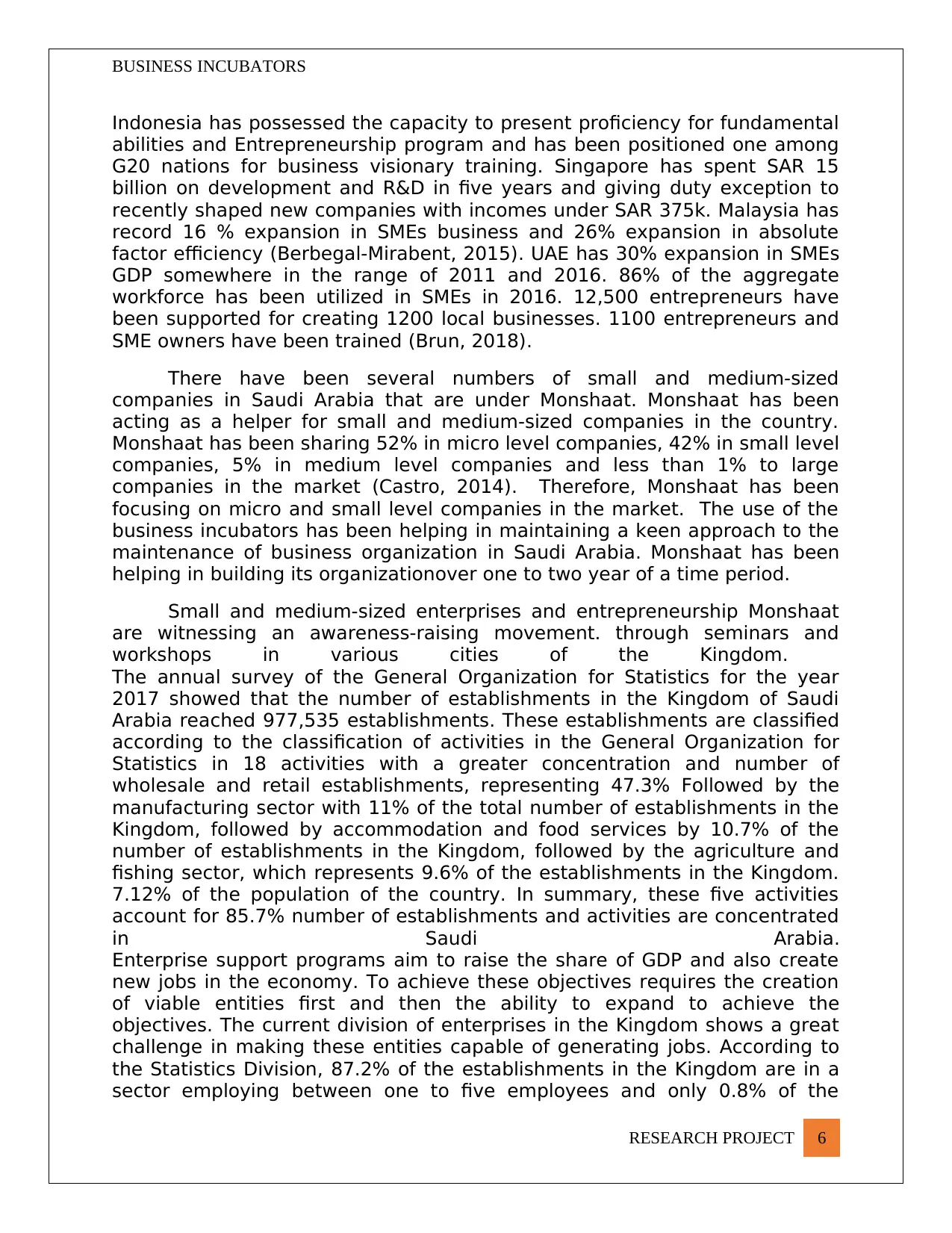
BUSINESS INCUBATORS
Indonesia has possessed the capacity to present proficiency for fundamental
abilities and Entrepreneurship program and has been positioned one among
G20 nations for business visionary training. Singapore has spent SAR 15
billion on development and R&D in five years and giving duty exception to
recently shaped new companies with incomes under SAR 375k. Malaysia has
record 16 % expansion in SMEs business and 26% expansion in absolute
factor efficiency (Berbegal-Mirabent, 2015). UAE has 30% expansion in SMEs
GDP somewhere in the range of 2011 and 2016. 86% of the aggregate
workforce has been utilized in SMEs in 2016. 12,500 entrepreneurs have
been supported for creating 1200 local businesses. 1100 entrepreneurs and
SME owners have been trained (Brun, 2018).
There have been several numbers of small and medium-sized
companies in Saudi Arabia that are under Monshaat. Monshaat has been
acting as a helper for small and medium-sized companies in the country.
Monshaat has been sharing 52% in micro level companies, 42% in small level
companies, 5% in medium level companies and less than 1% to large
companies in the market (Castro, 2014). Therefore, Monshaat has been
focusing on micro and small level companies in the market. The use of the
business incubators has been helping in maintaining a keen approach to the
maintenance of business organization in Saudi Arabia. Monshaat has been
helping in building its organizationover one to two year of a time period.
Small and medium-sized enterprises and entrepreneurship Monshaat
are witnessing an awareness-raising movement. through seminars and
workshops in various cities of the Kingdom.
The annual survey of the General Organization for Statistics for the year
2017 showed that the number of establishments in the Kingdom of Saudi
Arabia reached 977,535 establishments. These establishments are classified
according to the classification of activities in the General Organization for
Statistics in 18 activities with a greater concentration and number of
wholesale and retail establishments, representing 47.3% Followed by the
manufacturing sector with 11% of the total number of establishments in the
Kingdom, followed by accommodation and food services by 10.7% of the
number of establishments in the Kingdom, followed by the agriculture and
fishing sector, which represents 9.6% of the establishments in the Kingdom.
7.12% of the population of the country. In summary, these five activities
account for 85.7% number of establishments and activities are concentrated
in Saudi Arabia.
Enterprise support programs aim to raise the share of GDP and also create
new jobs in the economy. To achieve these objectives requires the creation
of viable entities first and then the ability to expand to achieve the
objectives. The current division of enterprises in the Kingdom shows a great
challenge in making these entities capable of generating jobs. According to
the Statistics Division, 87.2% of the establishments in the Kingdom are in a
sector employing between one to five employees and only 0.8% of the
RESEARCH PROJECT 6
Indonesia has possessed the capacity to present proficiency for fundamental
abilities and Entrepreneurship program and has been positioned one among
G20 nations for business visionary training. Singapore has spent SAR 15
billion on development and R&D in five years and giving duty exception to
recently shaped new companies with incomes under SAR 375k. Malaysia has
record 16 % expansion in SMEs business and 26% expansion in absolute
factor efficiency (Berbegal-Mirabent, 2015). UAE has 30% expansion in SMEs
GDP somewhere in the range of 2011 and 2016. 86% of the aggregate
workforce has been utilized in SMEs in 2016. 12,500 entrepreneurs have
been supported for creating 1200 local businesses. 1100 entrepreneurs and
SME owners have been trained (Brun, 2018).
There have been several numbers of small and medium-sized
companies in Saudi Arabia that are under Monshaat. Monshaat has been
acting as a helper for small and medium-sized companies in the country.
Monshaat has been sharing 52% in micro level companies, 42% in small level
companies, 5% in medium level companies and less than 1% to large
companies in the market (Castro, 2014). Therefore, Monshaat has been
focusing on micro and small level companies in the market. The use of the
business incubators has been helping in maintaining a keen approach to the
maintenance of business organization in Saudi Arabia. Monshaat has been
helping in building its organizationover one to two year of a time period.
Small and medium-sized enterprises and entrepreneurship Monshaat
are witnessing an awareness-raising movement. through seminars and
workshops in various cities of the Kingdom.
The annual survey of the General Organization for Statistics for the year
2017 showed that the number of establishments in the Kingdom of Saudi
Arabia reached 977,535 establishments. These establishments are classified
according to the classification of activities in the General Organization for
Statistics in 18 activities with a greater concentration and number of
wholesale and retail establishments, representing 47.3% Followed by the
manufacturing sector with 11% of the total number of establishments in the
Kingdom, followed by accommodation and food services by 10.7% of the
number of establishments in the Kingdom, followed by the agriculture and
fishing sector, which represents 9.6% of the establishments in the Kingdom.
7.12% of the population of the country. In summary, these five activities
account for 85.7% number of establishments and activities are concentrated
in Saudi Arabia.
Enterprise support programs aim to raise the share of GDP and also create
new jobs in the economy. To achieve these objectives requires the creation
of viable entities first and then the ability to expand to achieve the
objectives. The current division of enterprises in the Kingdom shows a great
challenge in making these entities capable of generating jobs. According to
the Statistics Division, 87.2% of the establishments in the Kingdom are in a
sector employing between one to five employees and only 0.8% of the
RESEARCH PROJECT 6
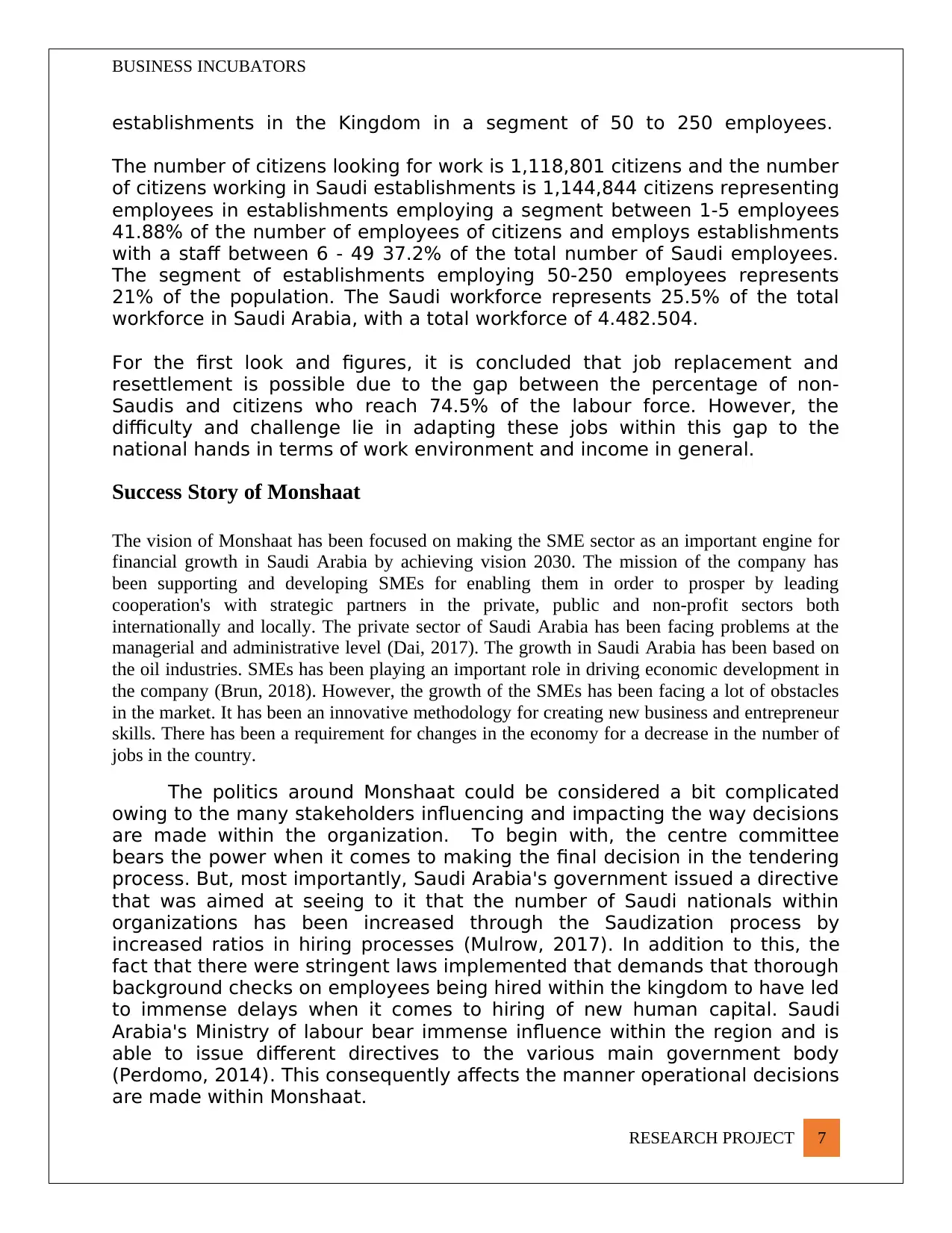
BUSINESS INCUBATORS
establishments in the Kingdom in a segment of 50 to 250 employees.
The number of citizens looking for work is 1,118,801 citizens and the number
of citizens working in Saudi establishments is 1,144,844 citizens representing
employees in establishments employing a segment between 1-5 employees
41.88% of the number of employees of citizens and employs establishments
with a staff between 6 - 49 37.2% of the total number of Saudi employees.
The segment of establishments employing 50-250 employees represents
21% of the population. The Saudi workforce represents 25.5% of the total
workforce in Saudi Arabia, with a total workforce of 4.482.504.
For the first look and figures, it is concluded that job replacement and
resettlement is possible due to the gap between the percentage of non-
Saudis and citizens who reach 74.5% of the labour force. However, the
difficulty and challenge lie in adapting these jobs within this gap to the
national hands in terms of work environment and income in general.
Success Story of Monshaat
The vision of Monshaat has been focused on making the SME sector as an important engine for
financial growth in Saudi Arabia by achieving vision 2030. The mission of the company has
been supporting and developing SMEs for enabling them in order to prosper by leading
cooperation's with strategic partners in the private, public and non-profit sectors both
internationally and locally. The private sector of Saudi Arabia has been facing problems at the
managerial and administrative level (Dai, 2017). The growth in Saudi Arabia has been based on
the oil industries. SMEs has been playing an important role in driving economic development in
the company (Brun, 2018). However, the growth of the SMEs has been facing a lot of obstacles
in the market. It has been an innovative methodology for creating new business and entrepreneur
skills. There has been a requirement for changes in the economy for a decrease in the number of
jobs in the country.
The politics around Monshaat could be considered a bit complicated
owing to the many stakeholders influencing and impacting the way decisions
are made within the organization. To begin with, the centre committee
bears the power when it comes to making the final decision in the tendering
process. But, most importantly, Saudi Arabia's government issued a directive
that was aimed at seeing to it that the number of Saudi nationals within
organizations has been increased through the Saudization process by
increased ratios in hiring processes (Mulrow, 2017). In addition to this, the
fact that there were stringent laws implemented that demands that thorough
background checks on employees being hired within the kingdom to have led
to immense delays when it comes to hiring of new human capital. Saudi
Arabia's Ministry of labour bear immense influence within the region and is
able to issue different directives to the various main government body
(Perdomo, 2014). This consequently affects the manner operational decisions
are made within Monshaat.
RESEARCH PROJECT 7
establishments in the Kingdom in a segment of 50 to 250 employees.
The number of citizens looking for work is 1,118,801 citizens and the number
of citizens working in Saudi establishments is 1,144,844 citizens representing
employees in establishments employing a segment between 1-5 employees
41.88% of the number of employees of citizens and employs establishments
with a staff between 6 - 49 37.2% of the total number of Saudi employees.
The segment of establishments employing 50-250 employees represents
21% of the population. The Saudi workforce represents 25.5% of the total
workforce in Saudi Arabia, with a total workforce of 4.482.504.
For the first look and figures, it is concluded that job replacement and
resettlement is possible due to the gap between the percentage of non-
Saudis and citizens who reach 74.5% of the labour force. However, the
difficulty and challenge lie in adapting these jobs within this gap to the
national hands in terms of work environment and income in general.
Success Story of Monshaat
The vision of Monshaat has been focused on making the SME sector as an important engine for
financial growth in Saudi Arabia by achieving vision 2030. The mission of the company has
been supporting and developing SMEs for enabling them in order to prosper by leading
cooperation's with strategic partners in the private, public and non-profit sectors both
internationally and locally. The private sector of Saudi Arabia has been facing problems at the
managerial and administrative level (Dai, 2017). The growth in Saudi Arabia has been based on
the oil industries. SMEs has been playing an important role in driving economic development in
the company (Brun, 2018). However, the growth of the SMEs has been facing a lot of obstacles
in the market. It has been an innovative methodology for creating new business and entrepreneur
skills. There has been a requirement for changes in the economy for a decrease in the number of
jobs in the country.
The politics around Monshaat could be considered a bit complicated
owing to the many stakeholders influencing and impacting the way decisions
are made within the organization. To begin with, the centre committee
bears the power when it comes to making the final decision in the tendering
process. But, most importantly, Saudi Arabia's government issued a directive
that was aimed at seeing to it that the number of Saudi nationals within
organizations has been increased through the Saudization process by
increased ratios in hiring processes (Mulrow, 2017). In addition to this, the
fact that there were stringent laws implemented that demands that thorough
background checks on employees being hired within the kingdom to have led
to immense delays when it comes to hiring of new human capital. Saudi
Arabia's Ministry of labour bear immense influence within the region and is
able to issue different directives to the various main government body
(Perdomo, 2014). This consequently affects the manner operational decisions
are made within Monshaat.
RESEARCH PROJECT 7
Paraphrase This Document
Need a fresh take? Get an instant paraphrase of this document with our AI Paraphraser
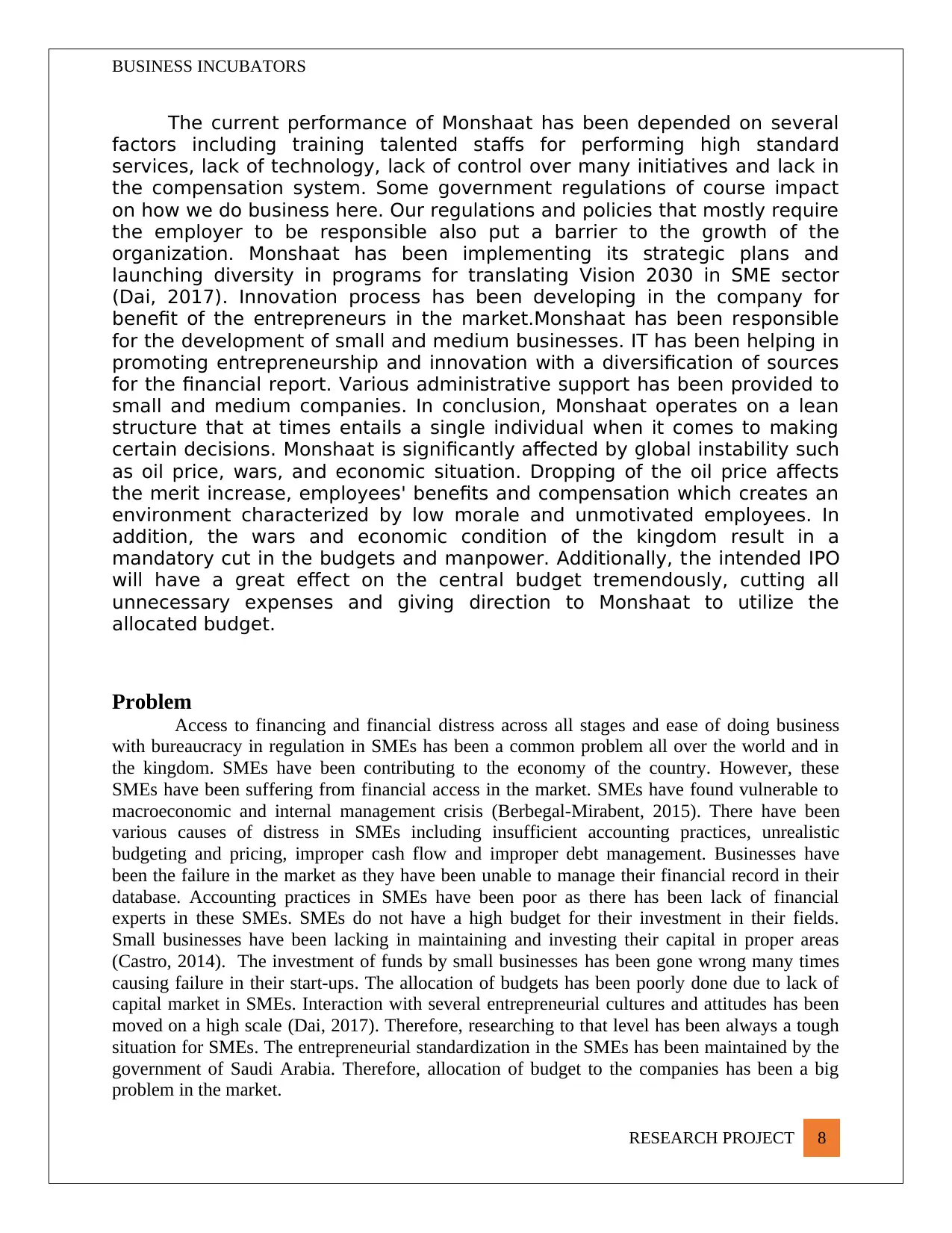
BUSINESS INCUBATORS
The current performance of Monshaat has been depended on several
factors including training talented staffs for performing high standard
services, lack of technology, lack of control over many initiatives and lack in
the compensation system. Some government regulations of course impact
on how we do business here. Our regulations and policies that mostly require
the employer to be responsible also put a barrier to the growth of the
organization. Monshaat has been implementing its strategic plans and
launching diversity in programs for translating Vision 2030 in SME sector
(Dai, 2017). Innovation process has been developing in the company for
benefit of the entrepreneurs in the market.Monshaat has been responsible
for the development of small and medium businesses. IT has been helping in
promoting entrepreneurship and innovation with a diversification of sources
for the financial report. Various administrative support has been provided to
small and medium companies. In conclusion, Monshaat operates on a lean
structure that at times entails a single individual when it comes to making
certain decisions. Monshaat is significantly affected by global instability such
as oil price, wars, and economic situation. Dropping of the oil price affects
the merit increase, employees' benefits and compensation which creates an
environment characterized by low morale and unmotivated employees. In
addition, the wars and economic condition of the kingdom result in a
mandatory cut in the budgets and manpower. Additionally, the intended IPO
will have a great effect on the central budget tremendously, cutting all
unnecessary expenses and giving direction to Monshaat to utilize the
allocated budget.
Problem
Access to financing and financial distress across all stages and ease of doing business
with bureaucracy in regulation in SMEs has been a common problem all over the world and in
the kingdom. SMEs have been contributing to the economy of the country. However, these
SMEs have been suffering from financial access in the market. SMEs have found vulnerable to
macroeconomic and internal management crisis (Berbegal-Mirabent, 2015). There have been
various causes of distress in SMEs including insufficient accounting practices, unrealistic
budgeting and pricing, improper cash flow and improper debt management. Businesses have
been the failure in the market as they have been unable to manage their financial record in their
database. Accounting practices in SMEs have been poor as there has been lack of financial
experts in these SMEs. SMEs do not have a high budget for their investment in their fields.
Small businesses have been lacking in maintaining and investing their capital in proper areas
(Castro, 2014). The investment of funds by small businesses has been gone wrong many times
causing failure in their start-ups. The allocation of budgets has been poorly done due to lack of
capital market in SMEs. Interaction with several entrepreneurial cultures and attitudes has been
moved on a high scale (Dai, 2017). Therefore, researching to that level has been always a tough
situation for SMEs. The entrepreneurial standardization in the SMEs has been maintained by the
government of Saudi Arabia. Therefore, allocation of budget to the companies has been a big
problem in the market.
RESEARCH PROJECT 8
The current performance of Monshaat has been depended on several
factors including training talented staffs for performing high standard
services, lack of technology, lack of control over many initiatives and lack in
the compensation system. Some government regulations of course impact
on how we do business here. Our regulations and policies that mostly require
the employer to be responsible also put a barrier to the growth of the
organization. Monshaat has been implementing its strategic plans and
launching diversity in programs for translating Vision 2030 in SME sector
(Dai, 2017). Innovation process has been developing in the company for
benefit of the entrepreneurs in the market.Monshaat has been responsible
for the development of small and medium businesses. IT has been helping in
promoting entrepreneurship and innovation with a diversification of sources
for the financial report. Various administrative support has been provided to
small and medium companies. In conclusion, Monshaat operates on a lean
structure that at times entails a single individual when it comes to making
certain decisions. Monshaat is significantly affected by global instability such
as oil price, wars, and economic situation. Dropping of the oil price affects
the merit increase, employees' benefits and compensation which creates an
environment characterized by low morale and unmotivated employees. In
addition, the wars and economic condition of the kingdom result in a
mandatory cut in the budgets and manpower. Additionally, the intended IPO
will have a great effect on the central budget tremendously, cutting all
unnecessary expenses and giving direction to Monshaat to utilize the
allocated budget.
Problem
Access to financing and financial distress across all stages and ease of doing business
with bureaucracy in regulation in SMEs has been a common problem all over the world and in
the kingdom. SMEs have been contributing to the economy of the country. However, these
SMEs have been suffering from financial access in the market. SMEs have found vulnerable to
macroeconomic and internal management crisis (Berbegal-Mirabent, 2015). There have been
various causes of distress in SMEs including insufficient accounting practices, unrealistic
budgeting and pricing, improper cash flow and improper debt management. Businesses have
been the failure in the market as they have been unable to manage their financial record in their
database. Accounting practices in SMEs have been poor as there has been lack of financial
experts in these SMEs. SMEs do not have a high budget for their investment in their fields.
Small businesses have been lacking in maintaining and investing their capital in proper areas
(Castro, 2014). The investment of funds by small businesses has been gone wrong many times
causing failure in their start-ups. The allocation of budgets has been poorly done due to lack of
capital market in SMEs. Interaction with several entrepreneurial cultures and attitudes has been
moved on a high scale (Dai, 2017). Therefore, researching to that level has been always a tough
situation for SMEs. The entrepreneurial standardization in the SMEs has been maintained by the
government of Saudi Arabia. Therefore, allocation of budget to the companies has been a big
problem in the market.
RESEARCH PROJECT 8
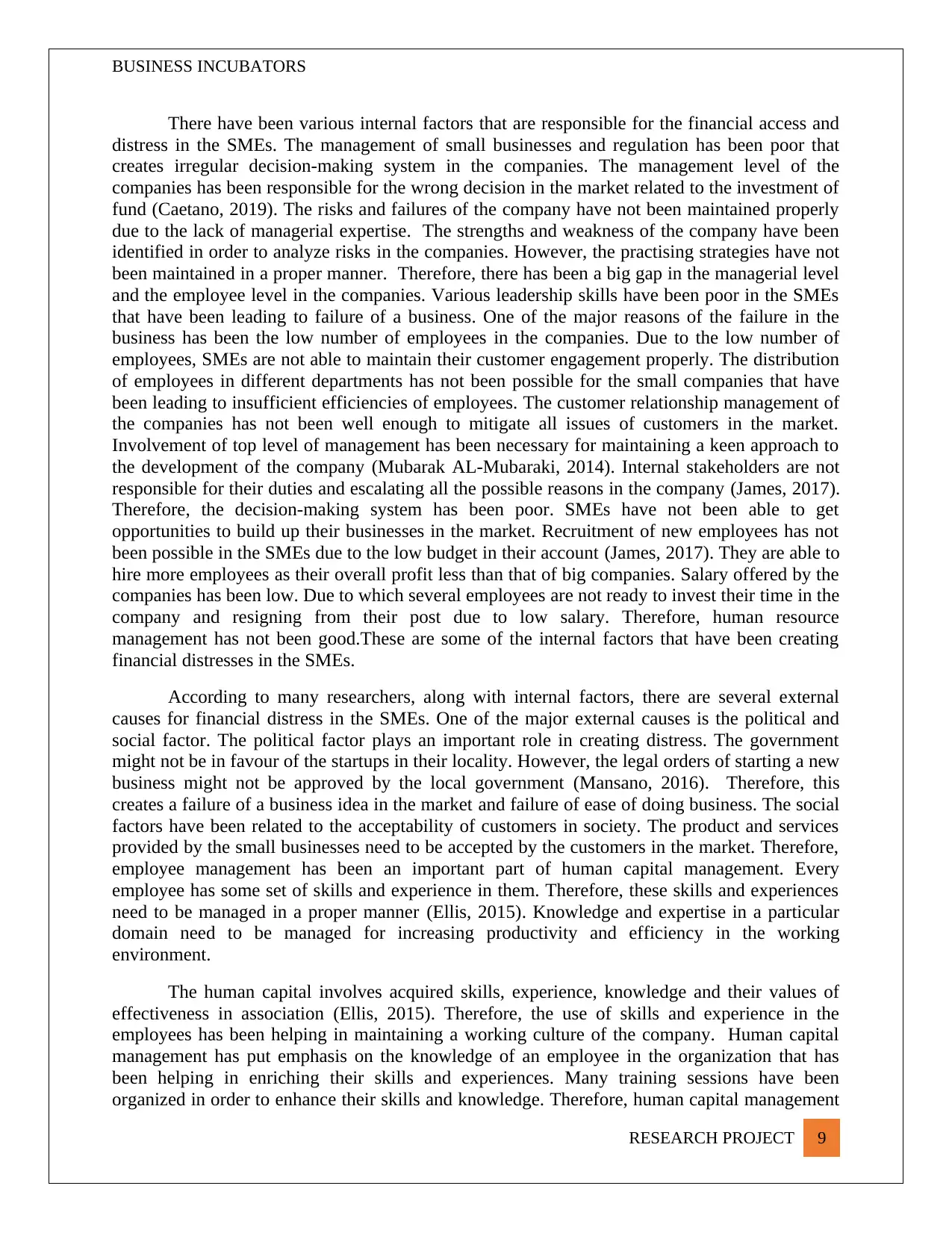
BUSINESS INCUBATORS
There have been various internal factors that are responsible for the financial access and
distress in the SMEs. The management of small businesses and regulation has been poor that
creates irregular decision-making system in the companies. The management level of the
companies has been responsible for the wrong decision in the market related to the investment of
fund (Caetano, 2019). The risks and failures of the company have not been maintained properly
due to the lack of managerial expertise. The strengths and weakness of the company have been
identified in order to analyze risks in the companies. However, the practising strategies have not
been maintained in a proper manner. Therefore, there has been a big gap in the managerial level
and the employee level in the companies. Various leadership skills have been poor in the SMEs
that have been leading to failure of a business. One of the major reasons of the failure in the
business has been the low number of employees in the companies. Due to the low number of
employees, SMEs are not able to maintain their customer engagement properly. The distribution
of employees in different departments has not been possible for the small companies that have
been leading to insufficient efficiencies of employees. The customer relationship management of
the companies has not been well enough to mitigate all issues of customers in the market.
Involvement of top level of management has been necessary for maintaining a keen approach to
the development of the company (Mubarak AL-Mubaraki, 2014). Internal stakeholders are not
responsible for their duties and escalating all the possible reasons in the company (James, 2017).
Therefore, the decision-making system has been poor. SMEs have not been able to get
opportunities to build up their businesses in the market. Recruitment of new employees has not
been possible in the SMEs due to the low budget in their account (James, 2017). They are able to
hire more employees as their overall profit less than that of big companies. Salary offered by the
companies has been low. Due to which several employees are not ready to invest their time in the
company and resigning from their post due to low salary. Therefore, human resource
management has not been good.These are some of the internal factors that have been creating
financial distresses in the SMEs.
According to many researchers, along with internal factors, there are several external
causes for financial distress in the SMEs. One of the major external causes is the political and
social factor. The political factor plays an important role in creating distress. The government
might not be in favour of the startups in their locality. However, the legal orders of starting a new
business might not be approved by the local government (Mansano, 2016). Therefore, this
creates a failure of a business idea in the market and failure of ease of doing business. The social
factors have been related to the acceptability of customers in society. The product and services
provided by the small businesses need to be accepted by the customers in the market. Therefore,
employee management has been an important part of human capital management. Every
employee has some set of skills and experience in them. Therefore, these skills and experiences
need to be managed in a proper manner (Ellis, 2015). Knowledge and expertise in a particular
domain need to be managed for increasing productivity and efficiency in the working
environment.
The human capital involves acquired skills, experience, knowledge and their values of
effectiveness in association (Ellis, 2015). Therefore, the use of skills and experience in the
employees has been helping in maintaining a working culture of the company. Human capital
management has put emphasis on the knowledge of an employee in the organization that has
been helping in enriching their skills and experiences. Many training sessions have been
organized in order to enhance their skills and knowledge. Therefore, human capital management
RESEARCH PROJECT 9
There have been various internal factors that are responsible for the financial access and
distress in the SMEs. The management of small businesses and regulation has been poor that
creates irregular decision-making system in the companies. The management level of the
companies has been responsible for the wrong decision in the market related to the investment of
fund (Caetano, 2019). The risks and failures of the company have not been maintained properly
due to the lack of managerial expertise. The strengths and weakness of the company have been
identified in order to analyze risks in the companies. However, the practising strategies have not
been maintained in a proper manner. Therefore, there has been a big gap in the managerial level
and the employee level in the companies. Various leadership skills have been poor in the SMEs
that have been leading to failure of a business. One of the major reasons of the failure in the
business has been the low number of employees in the companies. Due to the low number of
employees, SMEs are not able to maintain their customer engagement properly. The distribution
of employees in different departments has not been possible for the small companies that have
been leading to insufficient efficiencies of employees. The customer relationship management of
the companies has not been well enough to mitigate all issues of customers in the market.
Involvement of top level of management has been necessary for maintaining a keen approach to
the development of the company (Mubarak AL-Mubaraki, 2014). Internal stakeholders are not
responsible for their duties and escalating all the possible reasons in the company (James, 2017).
Therefore, the decision-making system has been poor. SMEs have not been able to get
opportunities to build up their businesses in the market. Recruitment of new employees has not
been possible in the SMEs due to the low budget in their account (James, 2017). They are able to
hire more employees as their overall profit less than that of big companies. Salary offered by the
companies has been low. Due to which several employees are not ready to invest their time in the
company and resigning from their post due to low salary. Therefore, human resource
management has not been good.These are some of the internal factors that have been creating
financial distresses in the SMEs.
According to many researchers, along with internal factors, there are several external
causes for financial distress in the SMEs. One of the major external causes is the political and
social factor. The political factor plays an important role in creating distress. The government
might not be in favour of the startups in their locality. However, the legal orders of starting a new
business might not be approved by the local government (Mansano, 2016). Therefore, this
creates a failure of a business idea in the market and failure of ease of doing business. The social
factors have been related to the acceptability of customers in society. The product and services
provided by the small businesses need to be accepted by the customers in the market. Therefore,
employee management has been an important part of human capital management. Every
employee has some set of skills and experience in them. Therefore, these skills and experiences
need to be managed in a proper manner (Ellis, 2015). Knowledge and expertise in a particular
domain need to be managed for increasing productivity and efficiency in the working
environment.
The human capital involves acquired skills, experience, knowledge and their values of
effectiveness in association (Ellis, 2015). Therefore, the use of skills and experience in the
employees has been helping in maintaining a working culture of the company. Human capital
management has put emphasis on the knowledge of an employee in the organization that has
been helping in enriching their skills and experiences. Many training sessions have been
organized in order to enhance their skills and knowledge. Therefore, human capital management
RESEARCH PROJECT 9
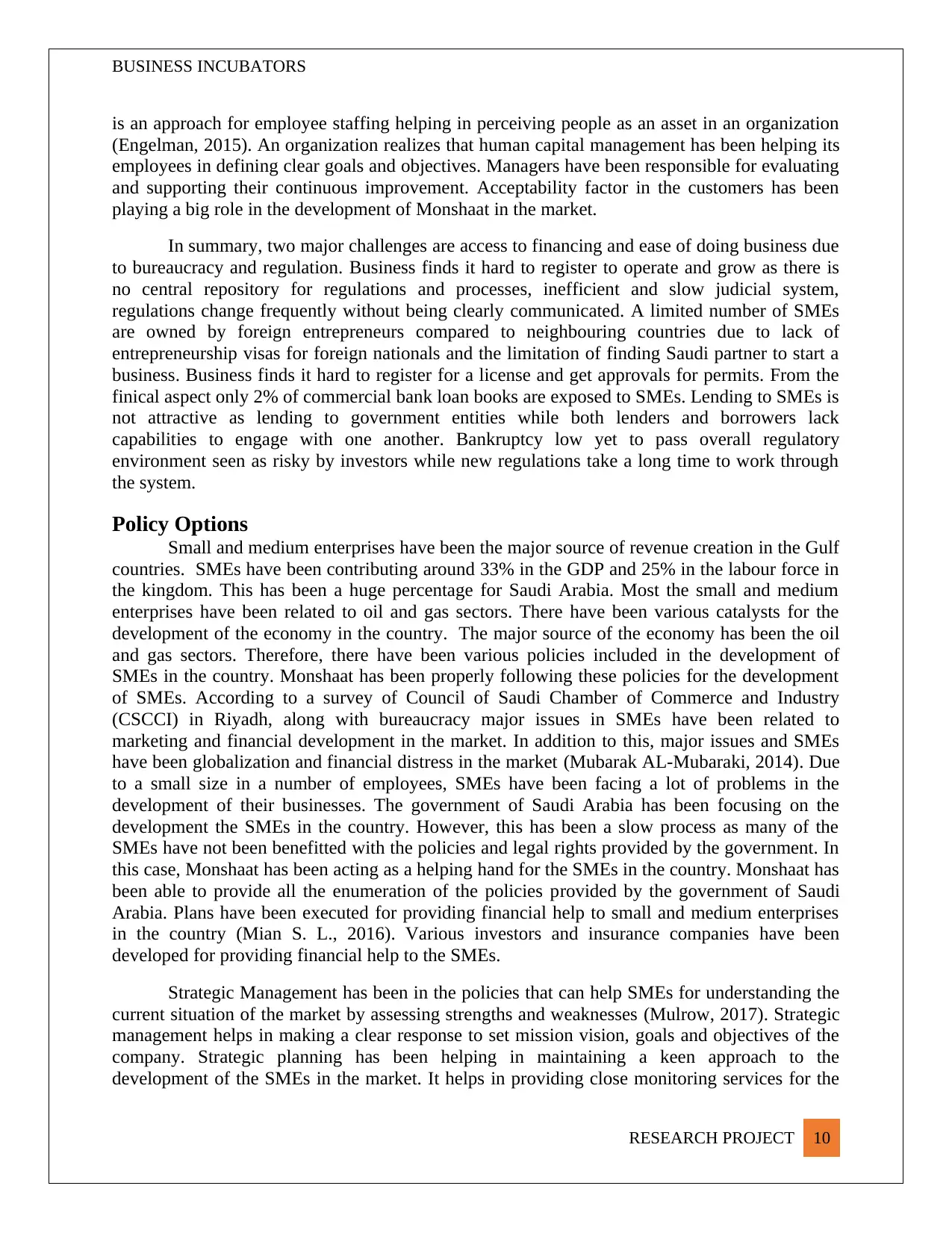
BUSINESS INCUBATORS
is an approach for employee staffing helping in perceiving people as an asset in an organization
(Engelman, 2015). An organization realizes that human capital management has been helping its
employees in defining clear goals and objectives. Managers have been responsible for evaluating
and supporting their continuous improvement. Acceptability factor in the customers has been
playing a big role in the development of Monshaat in the market.
In summary, two major challenges are access to financing and ease of doing business due
to bureaucracy and regulation. Business finds it hard to register to operate and grow as there is
no central repository for regulations and processes, inefficient and slow judicial system,
regulations change frequently without being clearly communicated. A limited number of SMEs
are owned by foreign entrepreneurs compared to neighbouring countries due to lack of
entrepreneurship visas for foreign nationals and the limitation of finding Saudi partner to start a
business. Business finds it hard to register for a license and get approvals for permits. From the
finical aspect only 2% of commercial bank loan books are exposed to SMEs. Lending to SMEs is
not attractive as lending to government entities while both lenders and borrowers lack
capabilities to engage with one another. Bankruptcy low yet to pass overall regulatory
environment seen as risky by investors while new regulations take a long time to work through
the system.
Policy Options
Small and medium enterprises have been the major source of revenue creation in the Gulf
countries. SMEs have been contributing around 33% in the GDP and 25% in the labour force in
the kingdom. This has been a huge percentage for Saudi Arabia. Most the small and medium
enterprises have been related to oil and gas sectors. There have been various catalysts for the
development of the economy in the country. The major source of the economy has been the oil
and gas sectors. Therefore, there have been various policies included in the development of
SMEs in the country. Monshaat has been properly following these policies for the development
of SMEs. According to a survey of Council of Saudi Chamber of Commerce and Industry
(CSCCI) in Riyadh, along with bureaucracy major issues in SMEs have been related to
marketing and financial development in the market. In addition to this, major issues and SMEs
have been globalization and financial distress in the market (Mubarak AL-Mubaraki, 2014). Due
to a small size in a number of employees, SMEs have been facing a lot of problems in the
development of their businesses. The government of Saudi Arabia has been focusing on the
development the SMEs in the country. However, this has been a slow process as many of the
SMEs have not been benefitted with the policies and legal rights provided by the government. In
this case, Monshaat has been acting as a helping hand for the SMEs in the country. Monshaat has
been able to provide all the enumeration of the policies provided by the government of Saudi
Arabia. Plans have been executed for providing financial help to small and medium enterprises
in the country (Mian S. L., 2016). Various investors and insurance companies have been
developed for providing financial help to the SMEs.
Strategic Management has been in the policies that can help SMEs for understanding the
current situation of the market by assessing strengths and weaknesses (Mulrow, 2017). Strategic
management helps in making a clear response to set mission vision, goals and objectives of the
company. Strategic planning has been helping in maintaining a keen approach to the
development of the SMEs in the market. It helps in providing close monitoring services for the
RESEARCH PROJECT 10
is an approach for employee staffing helping in perceiving people as an asset in an organization
(Engelman, 2015). An organization realizes that human capital management has been helping its
employees in defining clear goals and objectives. Managers have been responsible for evaluating
and supporting their continuous improvement. Acceptability factor in the customers has been
playing a big role in the development of Monshaat in the market.
In summary, two major challenges are access to financing and ease of doing business due
to bureaucracy and regulation. Business finds it hard to register to operate and grow as there is
no central repository for regulations and processes, inefficient and slow judicial system,
regulations change frequently without being clearly communicated. A limited number of SMEs
are owned by foreign entrepreneurs compared to neighbouring countries due to lack of
entrepreneurship visas for foreign nationals and the limitation of finding Saudi partner to start a
business. Business finds it hard to register for a license and get approvals for permits. From the
finical aspect only 2% of commercial bank loan books are exposed to SMEs. Lending to SMEs is
not attractive as lending to government entities while both lenders and borrowers lack
capabilities to engage with one another. Bankruptcy low yet to pass overall regulatory
environment seen as risky by investors while new regulations take a long time to work through
the system.
Policy Options
Small and medium enterprises have been the major source of revenue creation in the Gulf
countries. SMEs have been contributing around 33% in the GDP and 25% in the labour force in
the kingdom. This has been a huge percentage for Saudi Arabia. Most the small and medium
enterprises have been related to oil and gas sectors. There have been various catalysts for the
development of the economy in the country. The major source of the economy has been the oil
and gas sectors. Therefore, there have been various policies included in the development of
SMEs in the country. Monshaat has been properly following these policies for the development
of SMEs. According to a survey of Council of Saudi Chamber of Commerce and Industry
(CSCCI) in Riyadh, along with bureaucracy major issues in SMEs have been related to
marketing and financial development in the market. In addition to this, major issues and SMEs
have been globalization and financial distress in the market (Mubarak AL-Mubaraki, 2014). Due
to a small size in a number of employees, SMEs have been facing a lot of problems in the
development of their businesses. The government of Saudi Arabia has been focusing on the
development the SMEs in the country. However, this has been a slow process as many of the
SMEs have not been benefitted with the policies and legal rights provided by the government. In
this case, Monshaat has been acting as a helping hand for the SMEs in the country. Monshaat has
been able to provide all the enumeration of the policies provided by the government of Saudi
Arabia. Plans have been executed for providing financial help to small and medium enterprises
in the country (Mian S. L., 2016). Various investors and insurance companies have been
developed for providing financial help to the SMEs.
Strategic Management has been in the policies that can help SMEs for understanding the
current situation of the market by assessing strengths and weaknesses (Mulrow, 2017). Strategic
management helps in making a clear response to set mission vision, goals and objectives of the
company. Strategic planning has been helping in maintaining a keen approach to the
development of the SMEs in the market. It helps in providing close monitoring services for the
RESEARCH PROJECT 10
Secure Best Marks with AI Grader
Need help grading? Try our AI Grader for instant feedback on your assignments.
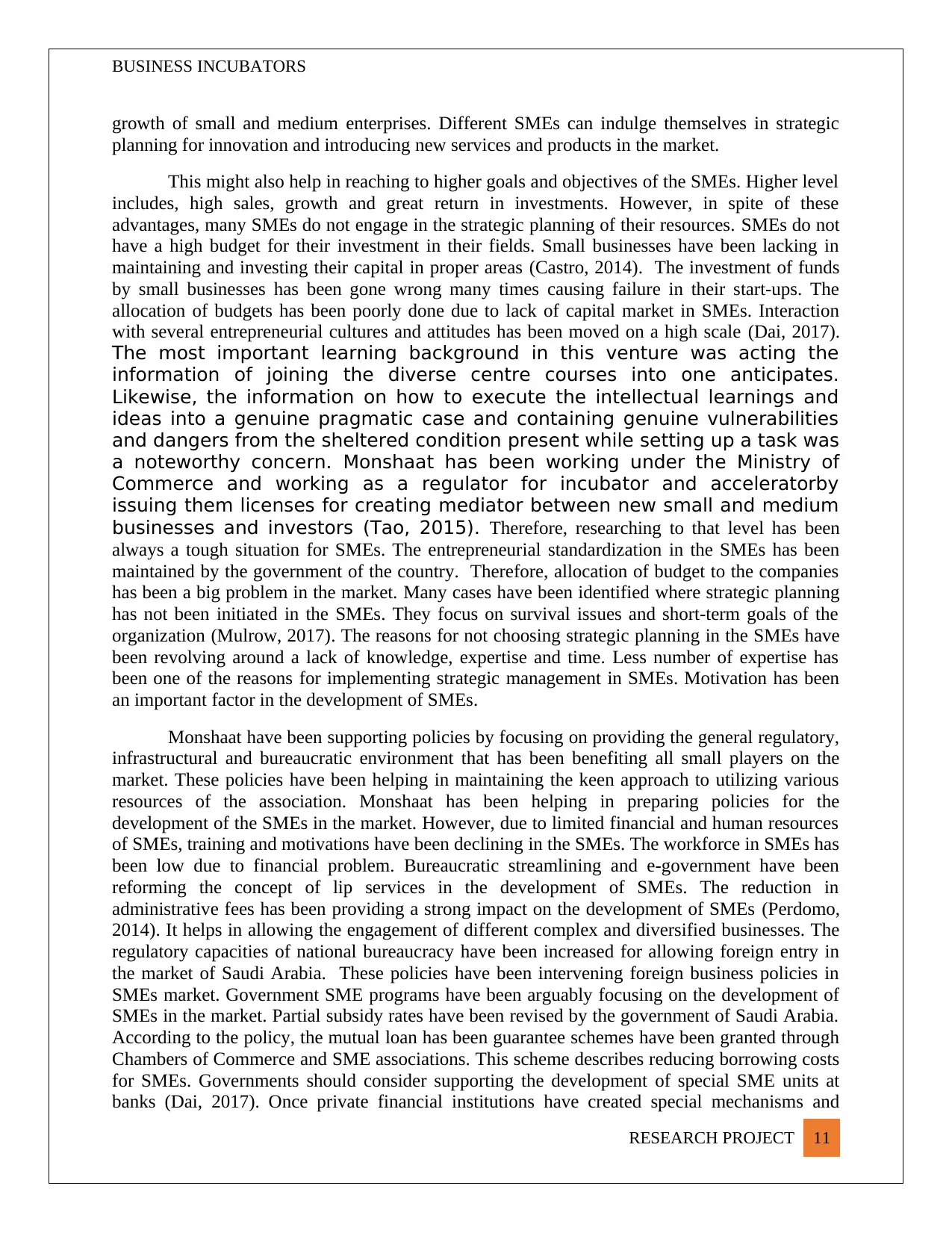
BUSINESS INCUBATORS
growth of small and medium enterprises. Different SMEs can indulge themselves in strategic
planning for innovation and introducing new services and products in the market.
This might also help in reaching to higher goals and objectives of the SMEs. Higher level
includes, high sales, growth and great return in investments. However, in spite of these
advantages, many SMEs do not engage in the strategic planning of their resources. SMEs do not
have a high budget for their investment in their fields. Small businesses have been lacking in
maintaining and investing their capital in proper areas (Castro, 2014). The investment of funds
by small businesses has been gone wrong many times causing failure in their start-ups. The
allocation of budgets has been poorly done due to lack of capital market in SMEs. Interaction
with several entrepreneurial cultures and attitudes has been moved on a high scale (Dai, 2017).
The most important learning background in this venture was acting the
information of joining the diverse centre courses into one anticipates.
Likewise, the information on how to execute the intellectual learnings and
ideas into a genuine pragmatic case and containing genuine vulnerabilities
and dangers from the sheltered condition present while setting up a task was
a noteworthy concern. Monshaat has been working under the Ministry of
Commerce and working as a regulator for incubator and acceleratorby
issuing them licenses for creating mediator between new small and medium
businesses and investors (Tao, 2015). Therefore, researching to that level has been
always a tough situation for SMEs. The entrepreneurial standardization in the SMEs has been
maintained by the government of the country. Therefore, allocation of budget to the companies
has been a big problem in the market. Many cases have been identified where strategic planning
has not been initiated in the SMEs. They focus on survival issues and short-term goals of the
organization (Mulrow, 2017). The reasons for not choosing strategic planning in the SMEs have
been revolving around a lack of knowledge, expertise and time. Less number of expertise has
been one of the reasons for implementing strategic management in SMEs. Motivation has been
an important factor in the development of SMEs.
Monshaat have been supporting policies by focusing on providing the general regulatory,
infrastructural and bureaucratic environment that has been benefiting all small players on the
market. These policies have been helping in maintaining the keen approach to utilizing various
resources of the association. Monshaat has been helping in preparing policies for the
development of the SMEs in the market. However, due to limited financial and human resources
of SMEs, training and motivations have been declining in the SMEs. The workforce in SMEs has
been low due to financial problem. Bureaucratic streamlining and e-government have been
reforming the concept of lip services in the development of SMEs. The reduction in
administrative fees has been providing a strong impact on the development of SMEs (Perdomo,
2014). It helps in allowing the engagement of different complex and diversified businesses. The
regulatory capacities of national bureaucracy have been increased for allowing foreign entry in
the market of Saudi Arabia. These policies have been intervening foreign business policies in
SMEs market. Government SME programs have been arguably focusing on the development of
SMEs in the market. Partial subsidy rates have been revised by the government of Saudi Arabia.
According to the policy, the mutual loan has been guarantee schemes have been granted through
Chambers of Commerce and SME associations. This scheme describes reducing borrowing costs
for SMEs. Governments should consider supporting the development of special SME units at
banks (Dai, 2017). Once private financial institutions have created special mechanisms and
RESEARCH PROJECT 11
growth of small and medium enterprises. Different SMEs can indulge themselves in strategic
planning for innovation and introducing new services and products in the market.
This might also help in reaching to higher goals and objectives of the SMEs. Higher level
includes, high sales, growth and great return in investments. However, in spite of these
advantages, many SMEs do not engage in the strategic planning of their resources. SMEs do not
have a high budget for their investment in their fields. Small businesses have been lacking in
maintaining and investing their capital in proper areas (Castro, 2014). The investment of funds
by small businesses has been gone wrong many times causing failure in their start-ups. The
allocation of budgets has been poorly done due to lack of capital market in SMEs. Interaction
with several entrepreneurial cultures and attitudes has been moved on a high scale (Dai, 2017).
The most important learning background in this venture was acting the
information of joining the diverse centre courses into one anticipates.
Likewise, the information on how to execute the intellectual learnings and
ideas into a genuine pragmatic case and containing genuine vulnerabilities
and dangers from the sheltered condition present while setting up a task was
a noteworthy concern. Monshaat has been working under the Ministry of
Commerce and working as a regulator for incubator and acceleratorby
issuing them licenses for creating mediator between new small and medium
businesses and investors (Tao, 2015). Therefore, researching to that level has been
always a tough situation for SMEs. The entrepreneurial standardization in the SMEs has been
maintained by the government of the country. Therefore, allocation of budget to the companies
has been a big problem in the market. Many cases have been identified where strategic planning
has not been initiated in the SMEs. They focus on survival issues and short-term goals of the
organization (Mulrow, 2017). The reasons for not choosing strategic planning in the SMEs have
been revolving around a lack of knowledge, expertise and time. Less number of expertise has
been one of the reasons for implementing strategic management in SMEs. Motivation has been
an important factor in the development of SMEs.
Monshaat have been supporting policies by focusing on providing the general regulatory,
infrastructural and bureaucratic environment that has been benefiting all small players on the
market. These policies have been helping in maintaining the keen approach to utilizing various
resources of the association. Monshaat has been helping in preparing policies for the
development of the SMEs in the market. However, due to limited financial and human resources
of SMEs, training and motivations have been declining in the SMEs. The workforce in SMEs has
been low due to financial problem. Bureaucratic streamlining and e-government have been
reforming the concept of lip services in the development of SMEs. The reduction in
administrative fees has been providing a strong impact on the development of SMEs (Perdomo,
2014). It helps in allowing the engagement of different complex and diversified businesses. The
regulatory capacities of national bureaucracy have been increased for allowing foreign entry in
the market of Saudi Arabia. These policies have been intervening foreign business policies in
SMEs market. Government SME programs have been arguably focusing on the development of
SMEs in the market. Partial subsidy rates have been revised by the government of Saudi Arabia.
According to the policy, the mutual loan has been guarantee schemes have been granted through
Chambers of Commerce and SME associations. This scheme describes reducing borrowing costs
for SMEs. Governments should consider supporting the development of special SME units at
banks (Dai, 2017). Once private financial institutions have created special mechanisms and
RESEARCH PROJECT 11
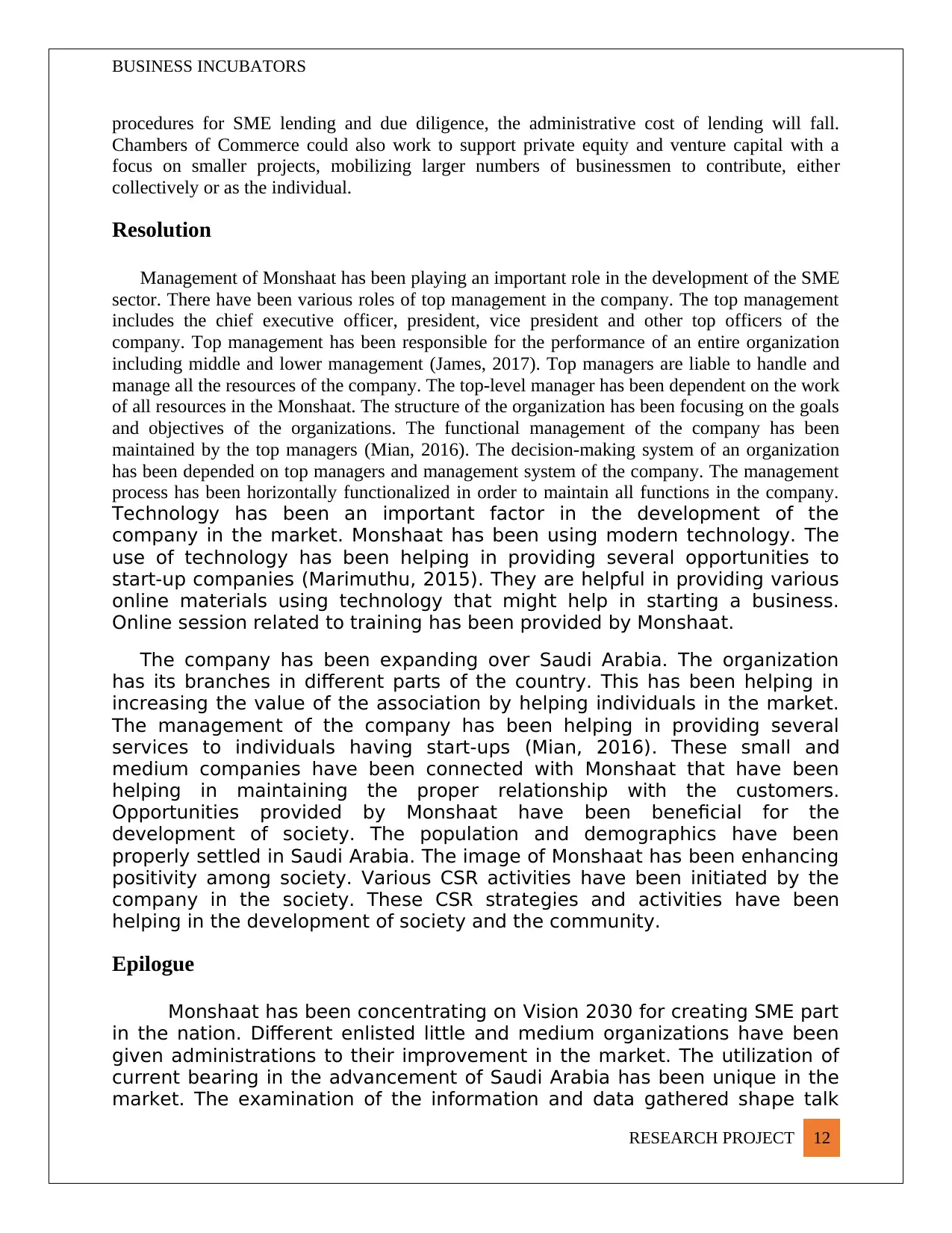
BUSINESS INCUBATORS
procedures for SME lending and due diligence, the administrative cost of lending will fall.
Chambers of Commerce could also work to support private equity and venture capital with a
focus on smaller projects, mobilizing larger numbers of businessmen to contribute, either
collectively or as the individual.
Resolution
Management of Monshaat has been playing an important role in the development of the SME
sector. There have been various roles of top management in the company. The top management
includes the chief executive officer, president, vice president and other top officers of the
company. Top management has been responsible for the performance of an entire organization
including middle and lower management (James, 2017). Top managers are liable to handle and
manage all the resources of the company. The top-level manager has been dependent on the work
of all resources in the Monshaat. The structure of the organization has been focusing on the goals
and objectives of the organizations. The functional management of the company has been
maintained by the top managers (Mian, 2016). The decision-making system of an organization
has been depended on top managers and management system of the company. The management
process has been horizontally functionalized in order to maintain all functions in the company.
Technology has been an important factor in the development of the
company in the market. Monshaat has been using modern technology. The
use of technology has been helping in providing several opportunities to
start-up companies (Marimuthu, 2015). They are helpful in providing various
online materials using technology that might help in starting a business.
Online session related to training has been provided by Monshaat.
The company has been expanding over Saudi Arabia. The organization
has its branches in different parts of the country. This has been helping in
increasing the value of the association by helping individuals in the market.
The management of the company has been helping in providing several
services to individuals having start-ups (Mian, 2016). These small and
medium companies have been connected with Monshaat that have been
helping in maintaining the proper relationship with the customers.
Opportunities provided by Monshaat have been beneficial for the
development of society. The population and demographics have been
properly settled in Saudi Arabia. The image of Monshaat has been enhancing
positivity among society. Various CSR activities have been initiated by the
company in the society. These CSR strategies and activities have been
helping in the development of society and the community.
Epilogue
Monshaat has been concentrating on Vision 2030 for creating SME part
in the nation. Different enlisted little and medium organizations have been
given administrations to their improvement in the market. The utilization of
current bearing in the advancement of Saudi Arabia has been unique in the
market. The examination of the information and data gathered shape talk
RESEARCH PROJECT 12
procedures for SME lending and due diligence, the administrative cost of lending will fall.
Chambers of Commerce could also work to support private equity and venture capital with a
focus on smaller projects, mobilizing larger numbers of businessmen to contribute, either
collectively or as the individual.
Resolution
Management of Monshaat has been playing an important role in the development of the SME
sector. There have been various roles of top management in the company. The top management
includes the chief executive officer, president, vice president and other top officers of the
company. Top management has been responsible for the performance of an entire organization
including middle and lower management (James, 2017). Top managers are liable to handle and
manage all the resources of the company. The top-level manager has been dependent on the work
of all resources in the Monshaat. The structure of the organization has been focusing on the goals
and objectives of the organizations. The functional management of the company has been
maintained by the top managers (Mian, 2016). The decision-making system of an organization
has been depended on top managers and management system of the company. The management
process has been horizontally functionalized in order to maintain all functions in the company.
Technology has been an important factor in the development of the
company in the market. Monshaat has been using modern technology. The
use of technology has been helping in providing several opportunities to
start-up companies (Marimuthu, 2015). They are helpful in providing various
online materials using technology that might help in starting a business.
Online session related to training has been provided by Monshaat.
The company has been expanding over Saudi Arabia. The organization
has its branches in different parts of the country. This has been helping in
increasing the value of the association by helping individuals in the market.
The management of the company has been helping in providing several
services to individuals having start-ups (Mian, 2016). These small and
medium companies have been connected with Monshaat that have been
helping in maintaining the proper relationship with the customers.
Opportunities provided by Monshaat have been beneficial for the
development of society. The population and demographics have been
properly settled in Saudi Arabia. The image of Monshaat has been enhancing
positivity among society. Various CSR activities have been initiated by the
company in the society. These CSR strategies and activities have been
helping in the development of society and the community.
Epilogue
Monshaat has been concentrating on Vision 2030 for creating SME part
in the nation. Different enlisted little and medium organizations have been
given administrations to their improvement in the market. The utilization of
current bearing in the advancement of Saudi Arabia has been unique in the
market. The examination of the information and data gathered shape talk
RESEARCH PROJECT 12
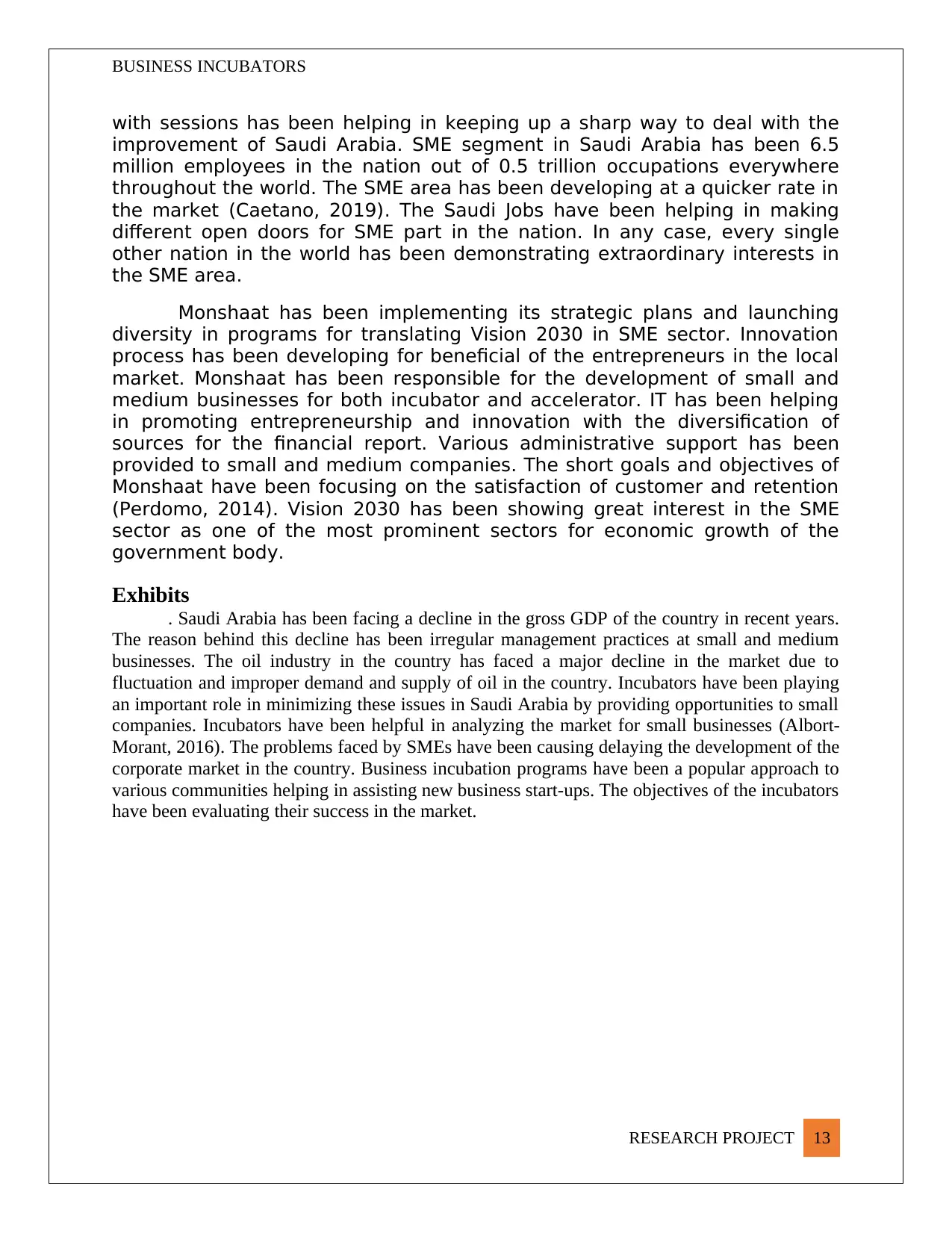
BUSINESS INCUBATORS
with sessions has been helping in keeping up a sharp way to deal with the
improvement of Saudi Arabia. SME segment in Saudi Arabia has been 6.5
million employees in the nation out of 0.5 trillion occupations everywhere
throughout the world. The SME area has been developing at a quicker rate in
the market (Caetano, 2019). The Saudi Jobs have been helping in making
different open doors for SME part in the nation. In any case, every single
other nation in the world has been demonstrating extraordinary interests in
the SME area.
Monshaat has been implementing its strategic plans and launching
diversity in programs for translating Vision 2030 in SME sector. Innovation
process has been developing for beneficial of the entrepreneurs in the local
market. Monshaat has been responsible for the development of small and
medium businesses for both incubator and accelerator. IT has been helping
in promoting entrepreneurship and innovation with the diversification of
sources for the financial report. Various administrative support has been
provided to small and medium companies. The short goals and objectives of
Monshaat have been focusing on the satisfaction of customer and retention
(Perdomo, 2014). Vision 2030 has been showing great interest in the SME
sector as one of the most prominent sectors for economic growth of the
government body.
Exhibits
. Saudi Arabia has been facing a decline in the gross GDP of the country in recent years.
The reason behind this decline has been irregular management practices at small and medium
businesses. The oil industry in the country has faced a major decline in the market due to
fluctuation and improper demand and supply of oil in the country. Incubators have been playing
an important role in minimizing these issues in Saudi Arabia by providing opportunities to small
companies. Incubators have been helpful in analyzing the market for small businesses (Albort-
Morant, 2016). The problems faced by SMEs have been causing delaying the development of the
corporate market in the country. Business incubation programs have been a popular approach to
various communities helping in assisting new business start-ups. The objectives of the incubators
have been evaluating their success in the market.
RESEARCH PROJECT 13
with sessions has been helping in keeping up a sharp way to deal with the
improvement of Saudi Arabia. SME segment in Saudi Arabia has been 6.5
million employees in the nation out of 0.5 trillion occupations everywhere
throughout the world. The SME area has been developing at a quicker rate in
the market (Caetano, 2019). The Saudi Jobs have been helping in making
different open doors for SME part in the nation. In any case, every single
other nation in the world has been demonstrating extraordinary interests in
the SME area.
Monshaat has been implementing its strategic plans and launching
diversity in programs for translating Vision 2030 in SME sector. Innovation
process has been developing for beneficial of the entrepreneurs in the local
market. Monshaat has been responsible for the development of small and
medium businesses for both incubator and accelerator. IT has been helping
in promoting entrepreneurship and innovation with the diversification of
sources for the financial report. Various administrative support has been
provided to small and medium companies. The short goals and objectives of
Monshaat have been focusing on the satisfaction of customer and retention
(Perdomo, 2014). Vision 2030 has been showing great interest in the SME
sector as one of the most prominent sectors for economic growth of the
government body.
Exhibits
. Saudi Arabia has been facing a decline in the gross GDP of the country in recent years.
The reason behind this decline has been irregular management practices at small and medium
businesses. The oil industry in the country has faced a major decline in the market due to
fluctuation and improper demand and supply of oil in the country. Incubators have been playing
an important role in minimizing these issues in Saudi Arabia by providing opportunities to small
companies. Incubators have been helpful in analyzing the market for small businesses (Albort-
Morant, 2016). The problems faced by SMEs have been causing delaying the development of the
corporate market in the country. Business incubation programs have been a popular approach to
various communities helping in assisting new business start-ups. The objectives of the incubators
have been evaluating their success in the market.
RESEARCH PROJECT 13
Paraphrase This Document
Need a fresh take? Get an instant paraphrase of this document with our AI Paraphraser
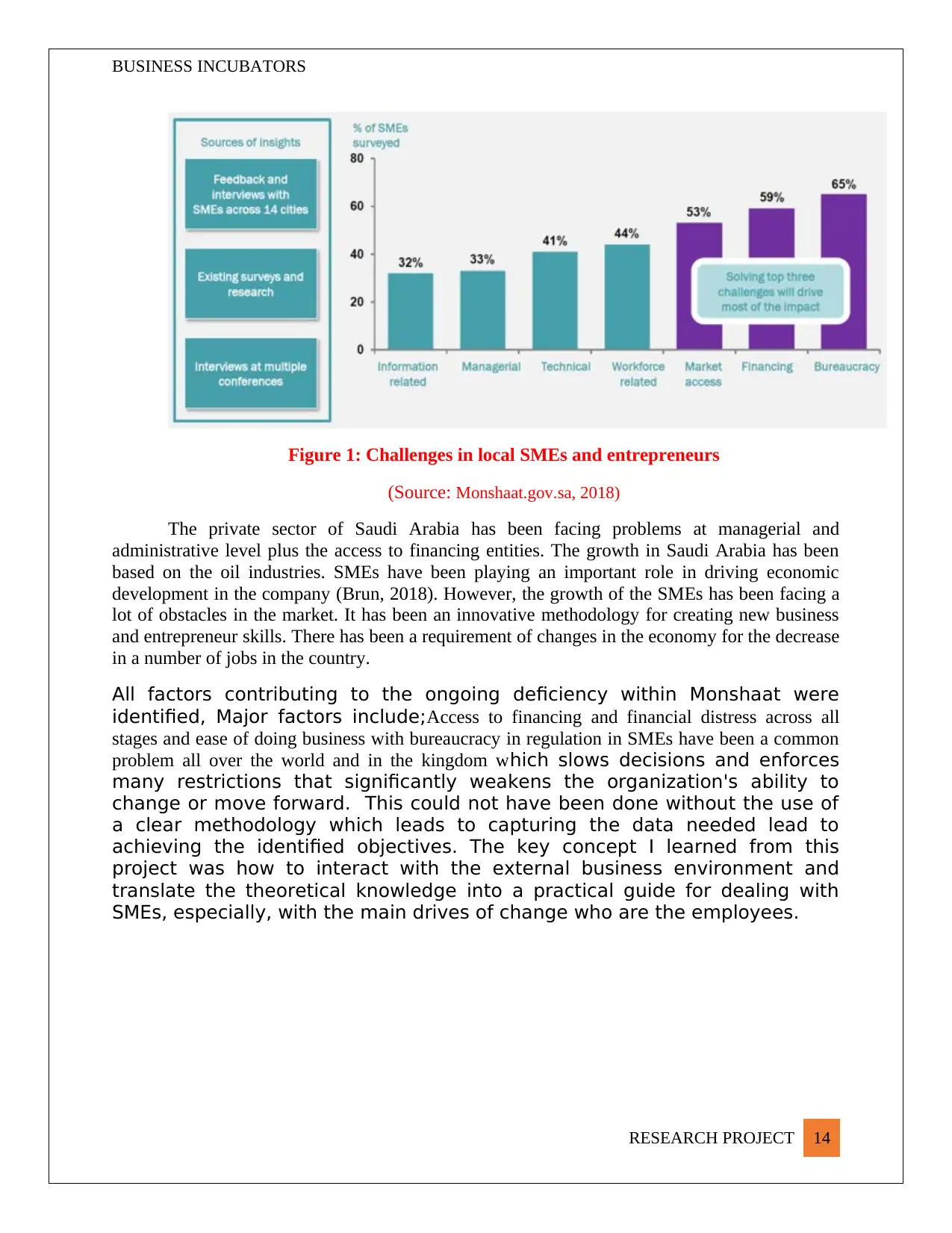
BUSINESS INCUBATORS
Figure 1: Challenges in local SMEs and entrepreneurs
(Source: Monshaat.gov.sa, 2018)
The private sector of Saudi Arabia has been facing problems at managerial and
administrative level plus the access to financing entities. The growth in Saudi Arabia has been
based on the oil industries. SMEs have been playing an important role in driving economic
development in the company (Brun, 2018). However, the growth of the SMEs has been facing a
lot of obstacles in the market. It has been an innovative methodology for creating new business
and entrepreneur skills. There has been a requirement of changes in the economy for the decrease
in a number of jobs in the country.
All factors contributing to the ongoing deficiency within Monshaat were
identified, Major factors include;Access to financing and financial distress across all
stages and ease of doing business with bureaucracy in regulation in SMEs have been a common
problem all over the world and in the kingdom which slows decisions and enforces
many restrictions that significantly weakens the organization's ability to
change or move forward. This could not have been done without the use of
a clear methodology which leads to capturing the data needed lead to
achieving the identified objectives. The key concept I learned from this
project was how to interact with the external business environment and
translate the theoretical knowledge into a practical guide for dealing with
SMEs, especially, with the main drives of change who are the employees.
RESEARCH PROJECT 14
Figure 1: Challenges in local SMEs and entrepreneurs
(Source: Monshaat.gov.sa, 2018)
The private sector of Saudi Arabia has been facing problems at managerial and
administrative level plus the access to financing entities. The growth in Saudi Arabia has been
based on the oil industries. SMEs have been playing an important role in driving economic
development in the company (Brun, 2018). However, the growth of the SMEs has been facing a
lot of obstacles in the market. It has been an innovative methodology for creating new business
and entrepreneur skills. There has been a requirement of changes in the economy for the decrease
in a number of jobs in the country.
All factors contributing to the ongoing deficiency within Monshaat were
identified, Major factors include;Access to financing and financial distress across all
stages and ease of doing business with bureaucracy in regulation in SMEs have been a common
problem all over the world and in the kingdom which slows decisions and enforces
many restrictions that significantly weakens the organization's ability to
change or move forward. This could not have been done without the use of
a clear methodology which leads to capturing the data needed lead to
achieving the identified objectives. The key concept I learned from this
project was how to interact with the external business environment and
translate the theoretical knowledge into a practical guide for dealing with
SMEs, especially, with the main drives of change who are the employees.
RESEARCH PROJECT 14
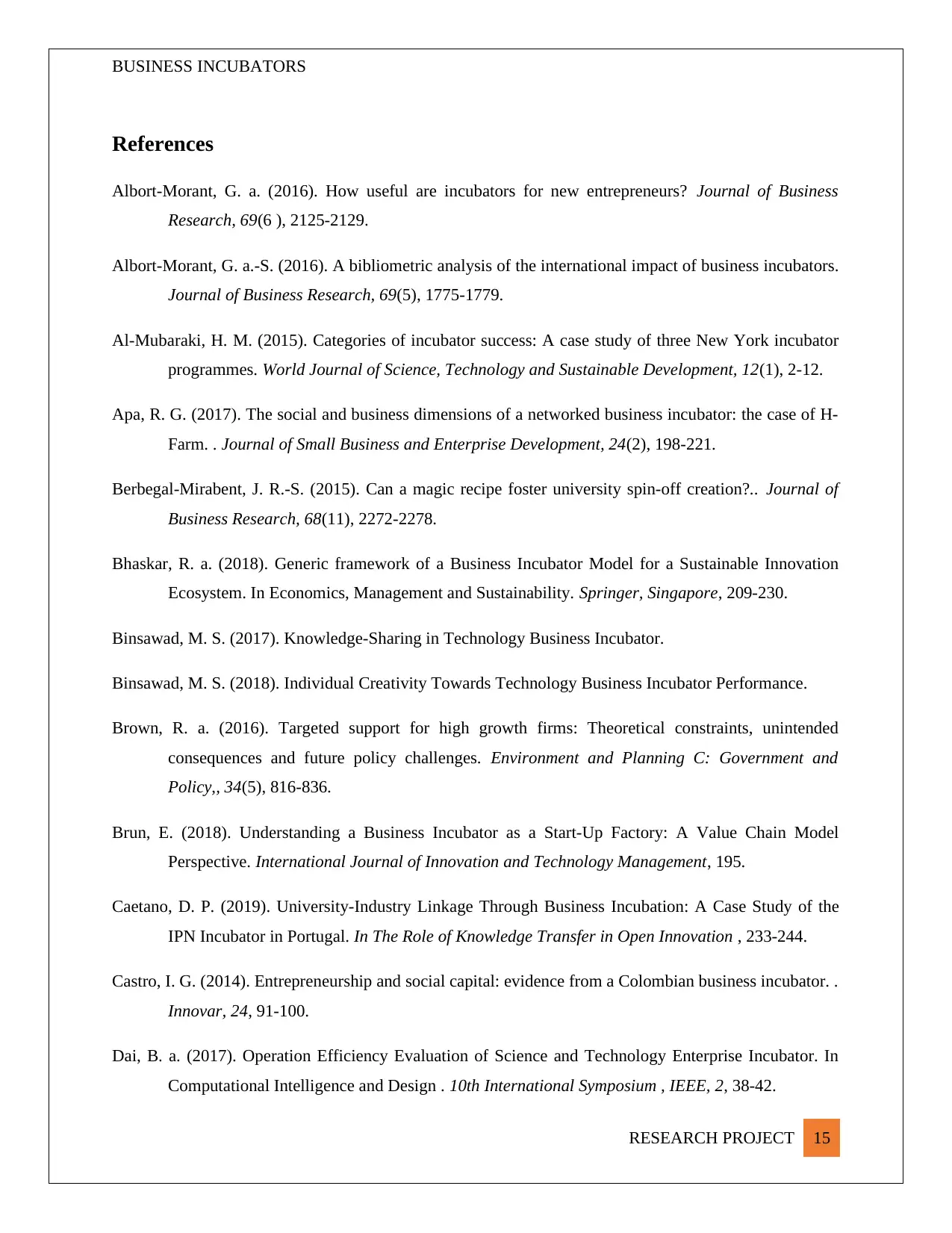
BUSINESS INCUBATORS
References
Albort-Morant, G. a. (2016). How useful are incubators for new entrepreneurs? Journal of Business
Research, 69(6 ), 2125-2129.
Albort-Morant, G. a.-S. (2016). A bibliometric analysis of the international impact of business incubators.
Journal of Business Research, 69(5), 1775-1779.
Al-Mubaraki, H. M. (2015). Categories of incubator success: A case study of three New York incubator
programmes. World Journal of Science, Technology and Sustainable Development, 12(1), 2-12.
Apa, R. G. (2017). The social and business dimensions of a networked business incubator: the case of H-
Farm. . Journal of Small Business and Enterprise Development, 24(2), 198-221.
Berbegal-Mirabent, J. R.-S. (2015). Can a magic recipe foster university spin-off creation?.. Journal of
Business Research, 68(11), 2272-2278.
Bhaskar, R. a. (2018). Generic framework of a Business Incubator Model for a Sustainable Innovation
Ecosystem. In Economics, Management and Sustainability. Springer, Singapore, 209-230.
Binsawad, M. S. (2017). Knowledge-Sharing in Technology Business Incubator.
Binsawad, M. S. (2018). Individual Creativity Towards Technology Business Incubator Performance.
Brown, R. a. (2016). Targeted support for high growth firms: Theoretical constraints, unintended
consequences and future policy challenges. Environment and Planning C: Government and
Policy,, 34(5), 816-836.
Brun, E. (2018). Understanding a Business Incubator as a Start-Up Factory: A Value Chain Model
Perspective. International Journal of Innovation and Technology Management, 195.
Caetano, D. P. (2019). University-Industry Linkage Through Business Incubation: A Case Study of the
IPN Incubator in Portugal. In The Role of Knowledge Transfer in Open Innovation , 233-244.
Castro, I. G. (2014). Entrepreneurship and social capital: evidence from a Colombian business incubator. .
Innovar, 24, 91-100.
Dai, B. a. (2017). Operation Efficiency Evaluation of Science and Technology Enterprise Incubator. In
Computational Intelligence and Design . 10th International Symposium , IEEE, 2, 38-42.
RESEARCH PROJECT 15
References
Albort-Morant, G. a. (2016). How useful are incubators for new entrepreneurs? Journal of Business
Research, 69(6 ), 2125-2129.
Albort-Morant, G. a.-S. (2016). A bibliometric analysis of the international impact of business incubators.
Journal of Business Research, 69(5), 1775-1779.
Al-Mubaraki, H. M. (2015). Categories of incubator success: A case study of three New York incubator
programmes. World Journal of Science, Technology and Sustainable Development, 12(1), 2-12.
Apa, R. G. (2017). The social and business dimensions of a networked business incubator: the case of H-
Farm. . Journal of Small Business and Enterprise Development, 24(2), 198-221.
Berbegal-Mirabent, J. R.-S. (2015). Can a magic recipe foster university spin-off creation?.. Journal of
Business Research, 68(11), 2272-2278.
Bhaskar, R. a. (2018). Generic framework of a Business Incubator Model for a Sustainable Innovation
Ecosystem. In Economics, Management and Sustainability. Springer, Singapore, 209-230.
Binsawad, M. S. (2017). Knowledge-Sharing in Technology Business Incubator.
Binsawad, M. S. (2018). Individual Creativity Towards Technology Business Incubator Performance.
Brown, R. a. (2016). Targeted support for high growth firms: Theoretical constraints, unintended
consequences and future policy challenges. Environment and Planning C: Government and
Policy,, 34(5), 816-836.
Brun, E. (2018). Understanding a Business Incubator as a Start-Up Factory: A Value Chain Model
Perspective. International Journal of Innovation and Technology Management, 195.
Caetano, D. P. (2019). University-Industry Linkage Through Business Incubation: A Case Study of the
IPN Incubator in Portugal. In The Role of Knowledge Transfer in Open Innovation , 233-244.
Castro, I. G. (2014). Entrepreneurship and social capital: evidence from a Colombian business incubator. .
Innovar, 24, 91-100.
Dai, B. a. (2017). Operation Efficiency Evaluation of Science and Technology Enterprise Incubator. In
Computational Intelligence and Design . 10th International Symposium , IEEE, 2, 38-42.
RESEARCH PROJECT 15
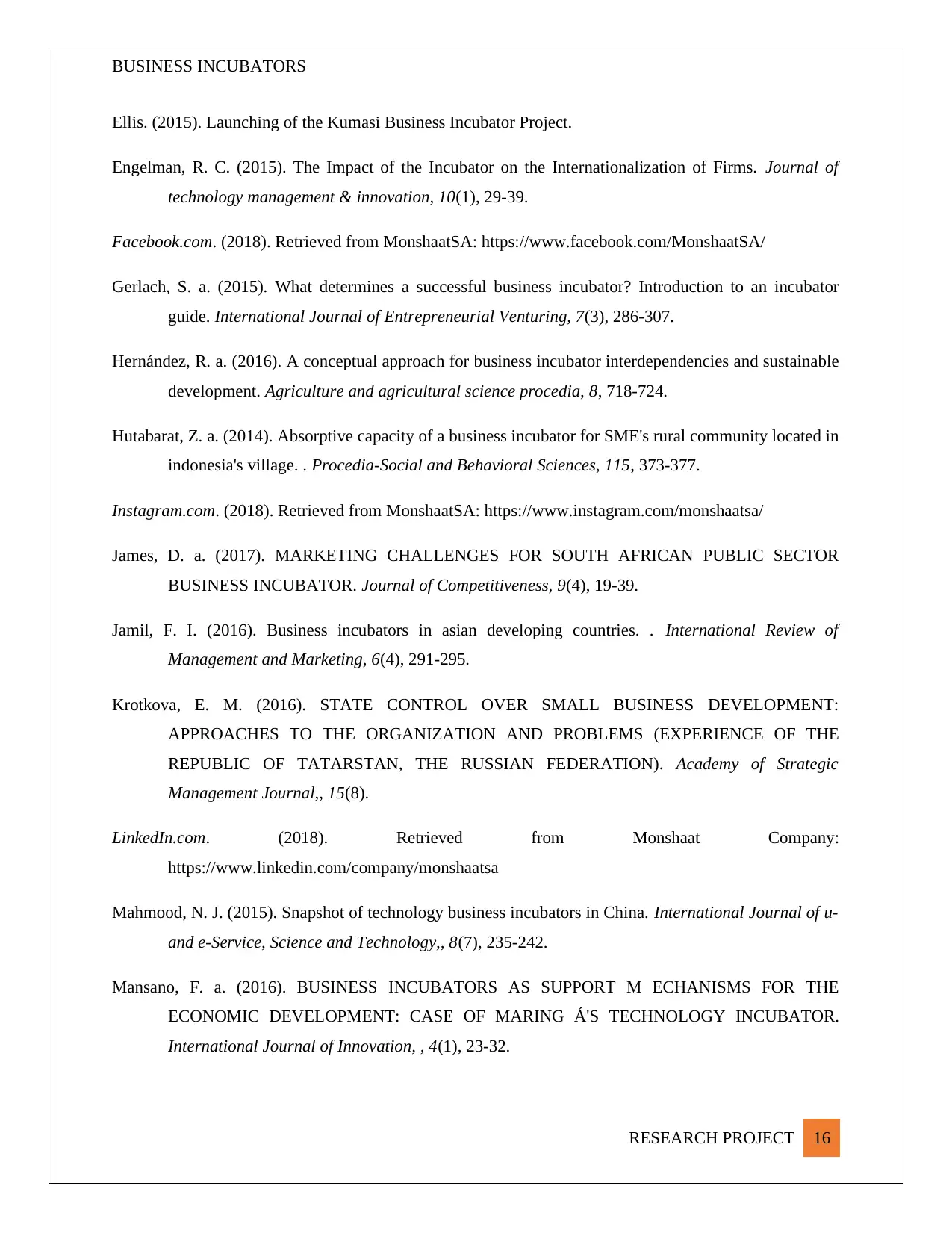
BUSINESS INCUBATORS
Ellis. (2015). Launching of the Kumasi Business Incubator Project.
Engelman, R. C. (2015). The Impact of the Incubator on the Internationalization of Firms. Journal of
technology management & innovation, 10(1), 29-39.
Facebook.com. (2018). Retrieved from MonshaatSA: https://www.facebook.com/MonshaatSA/
Gerlach, S. a. (2015). What determines a successful business incubator? Introduction to an incubator
guide. International Journal of Entrepreneurial Venturing, 7(3), 286-307.
Hernández, R. a. (2016). A conceptual approach for business incubator interdependencies and sustainable
development. Agriculture and agricultural science procedia, 8, 718-724.
Hutabarat, Z. a. (2014). Absorptive capacity of a business incubator for SME's rural community located in
indonesia's village. . Procedia-Social and Behavioral Sciences, 115, 373-377.
Instagram.com. (2018). Retrieved from MonshaatSA: https://www.instagram.com/monshaatsa/
James, D. a. (2017). MARKETING CHALLENGES FOR SOUTH AFRICAN PUBLIC SECTOR
BUSINESS INCUBATOR. Journal of Competitiveness, 9(4), 19-39.
Jamil, F. I. (2016). Business incubators in asian developing countries. . International Review of
Management and Marketing, 6(4), 291-295.
Krotkova, E. M. (2016). STATE CONTROL OVER SMALL BUSINESS DEVELOPMENT:
APPROACHES TO THE ORGANIZATION AND PROBLEMS (EXPERIENCE OF THE
REPUBLIC OF TATARSTAN, THE RUSSIAN FEDERATION). Academy of Strategic
Management Journal,, 15(8).
LinkedIn.com. (2018). Retrieved from Monshaat Company:
https://www.linkedin.com/company/monshaatsa
Mahmood, N. J. (2015). Snapshot of technology business incubators in China. International Journal of u-
and e-Service, Science and Technology,, 8(7), 235-242.
Mansano, F. a. (2016). BUSINESS INCUBATORS AS SUPPORT M ECHANISMS FOR THE
ECONOMIC DEVELOPMENT: CASE OF MARING Á'S TECHNOLOGY INCUBATOR.
International Journal of Innovation, , 4(1), 23-32.
RESEARCH PROJECT 16
Ellis. (2015). Launching of the Kumasi Business Incubator Project.
Engelman, R. C. (2015). The Impact of the Incubator on the Internationalization of Firms. Journal of
technology management & innovation, 10(1), 29-39.
Facebook.com. (2018). Retrieved from MonshaatSA: https://www.facebook.com/MonshaatSA/
Gerlach, S. a. (2015). What determines a successful business incubator? Introduction to an incubator
guide. International Journal of Entrepreneurial Venturing, 7(3), 286-307.
Hernández, R. a. (2016). A conceptual approach for business incubator interdependencies and sustainable
development. Agriculture and agricultural science procedia, 8, 718-724.
Hutabarat, Z. a. (2014). Absorptive capacity of a business incubator for SME's rural community located in
indonesia's village. . Procedia-Social and Behavioral Sciences, 115, 373-377.
Instagram.com. (2018). Retrieved from MonshaatSA: https://www.instagram.com/monshaatsa/
James, D. a. (2017). MARKETING CHALLENGES FOR SOUTH AFRICAN PUBLIC SECTOR
BUSINESS INCUBATOR. Journal of Competitiveness, 9(4), 19-39.
Jamil, F. I. (2016). Business incubators in asian developing countries. . International Review of
Management and Marketing, 6(4), 291-295.
Krotkova, E. M. (2016). STATE CONTROL OVER SMALL BUSINESS DEVELOPMENT:
APPROACHES TO THE ORGANIZATION AND PROBLEMS (EXPERIENCE OF THE
REPUBLIC OF TATARSTAN, THE RUSSIAN FEDERATION). Academy of Strategic
Management Journal,, 15(8).
LinkedIn.com. (2018). Retrieved from Monshaat Company:
https://www.linkedin.com/company/monshaatsa
Mahmood, N. J. (2015). Snapshot of technology business incubators in China. International Journal of u-
and e-Service, Science and Technology,, 8(7), 235-242.
Mansano, F. a. (2016). BUSINESS INCUBATORS AS SUPPORT M ECHANISMS FOR THE
ECONOMIC DEVELOPMENT: CASE OF MARING Á'S TECHNOLOGY INCUBATOR.
International Journal of Innovation, , 4(1), 23-32.
RESEARCH PROJECT 16
Secure Best Marks with AI Grader
Need help grading? Try our AI Grader for instant feedback on your assignments.
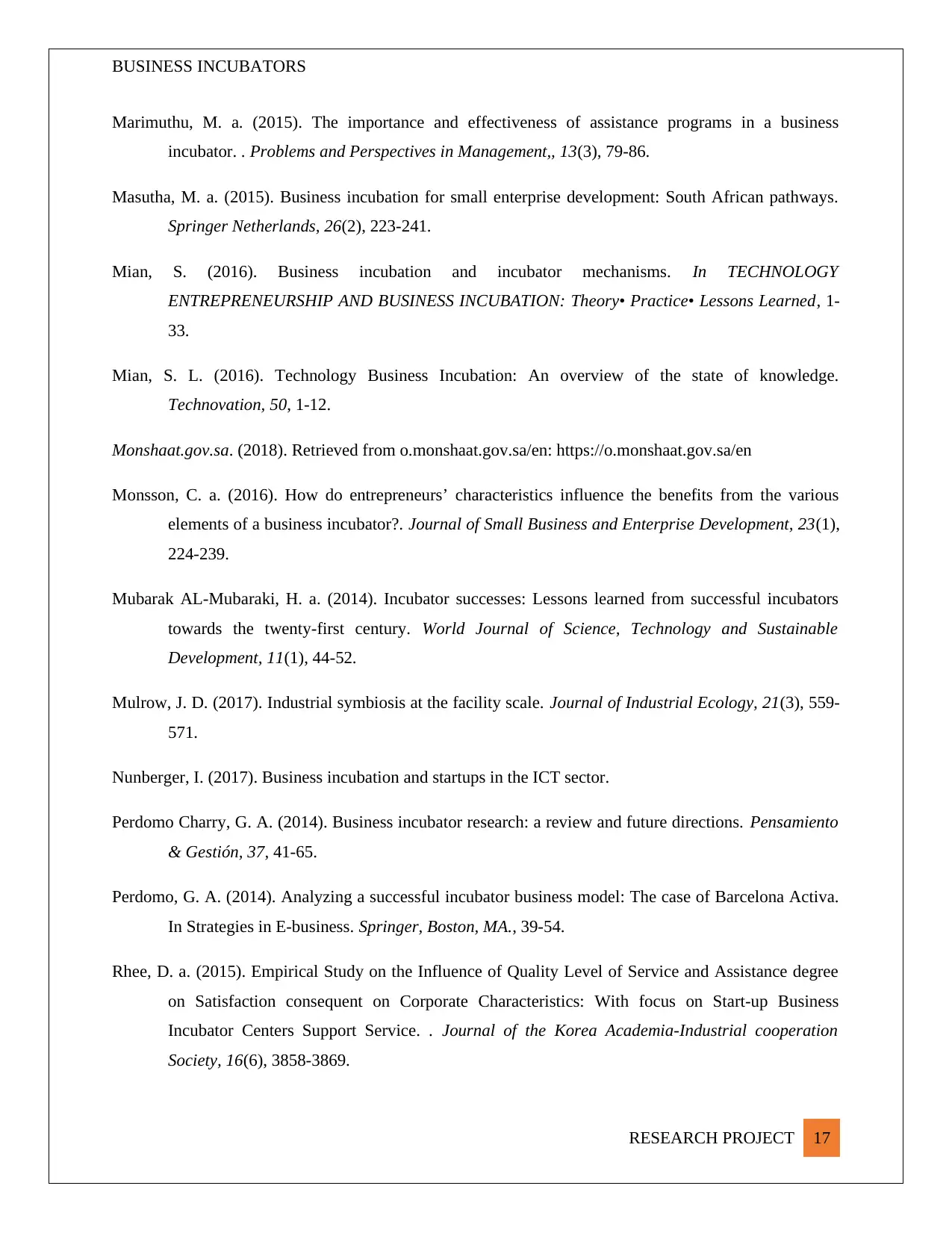
BUSINESS INCUBATORS
Marimuthu, M. a. (2015). The importance and effectiveness of assistance programs in a business
incubator. . Problems and Perspectives in Management,, 13(3), 79-86.
Masutha, M. a. (2015). Business incubation for small enterprise development: South African pathways.
Springer Netherlands, 26(2), 223-241.
Mian, S. (2016). Business incubation and incubator mechanisms. In TECHNOLOGY
ENTREPRENEURSHIP AND BUSINESS INCUBATION: Theory• Practice• Lessons Learned, 1-
33.
Mian, S. L. (2016). Technology Business Incubation: An overview of the state of knowledge.
Technovation, 50, 1-12.
Monshaat.gov.sa. (2018). Retrieved from o.monshaat.gov.sa/en: https://o.monshaat.gov.sa/en
Monsson, C. a. (2016). How do entrepreneurs’ characteristics influence the benefits from the various
elements of a business incubator?. Journal of Small Business and Enterprise Development, 23(1),
224-239.
Mubarak AL-Mubaraki, H. a. (2014). Incubator successes: Lessons learned from successful incubators
towards the twenty-first century. World Journal of Science, Technology and Sustainable
Development, 11(1), 44-52.
Mulrow, J. D. (2017). Industrial symbiosis at the facility scale. Journal of Industrial Ecology, 21(3), 559-
571.
Nunberger, I. (2017). Business incubation and startups in the ICT sector.
Perdomo Charry, G. A. (2014). Business incubator research: a review and future directions. Pensamiento
& Gestión, 37, 41-65.
Perdomo, G. A. (2014). Analyzing a successful incubator business model: The case of Barcelona Activa.
In Strategies in E-business. Springer, Boston, MA., 39-54.
Rhee, D. a. (2015). Empirical Study on the Influence of Quality Level of Service and Assistance degree
on Satisfaction consequent on Corporate Characteristics: With focus on Start-up Business
Incubator Centers Support Service. . Journal of the Korea Academia-Industrial cooperation
Society, 16(6), 3858-3869.
RESEARCH PROJECT 17
Marimuthu, M. a. (2015). The importance and effectiveness of assistance programs in a business
incubator. . Problems and Perspectives in Management,, 13(3), 79-86.
Masutha, M. a. (2015). Business incubation for small enterprise development: South African pathways.
Springer Netherlands, 26(2), 223-241.
Mian, S. (2016). Business incubation and incubator mechanisms. In TECHNOLOGY
ENTREPRENEURSHIP AND BUSINESS INCUBATION: Theory• Practice• Lessons Learned, 1-
33.
Mian, S. L. (2016). Technology Business Incubation: An overview of the state of knowledge.
Technovation, 50, 1-12.
Monshaat.gov.sa. (2018). Retrieved from o.monshaat.gov.sa/en: https://o.monshaat.gov.sa/en
Monsson, C. a. (2016). How do entrepreneurs’ characteristics influence the benefits from the various
elements of a business incubator?. Journal of Small Business and Enterprise Development, 23(1),
224-239.
Mubarak AL-Mubaraki, H. a. (2014). Incubator successes: Lessons learned from successful incubators
towards the twenty-first century. World Journal of Science, Technology and Sustainable
Development, 11(1), 44-52.
Mulrow, J. D. (2017). Industrial symbiosis at the facility scale. Journal of Industrial Ecology, 21(3), 559-
571.
Nunberger, I. (2017). Business incubation and startups in the ICT sector.
Perdomo Charry, G. A. (2014). Business incubator research: a review and future directions. Pensamiento
& Gestión, 37, 41-65.
Perdomo, G. A. (2014). Analyzing a successful incubator business model: The case of Barcelona Activa.
In Strategies in E-business. Springer, Boston, MA., 39-54.
Rhee, D. a. (2015). Empirical Study on the Influence of Quality Level of Service and Assistance degree
on Satisfaction consequent on Corporate Characteristics: With focus on Start-up Business
Incubator Centers Support Service. . Journal of the Korea Academia-Industrial cooperation
Society, 16(6), 3858-3869.
RESEARCH PROJECT 17
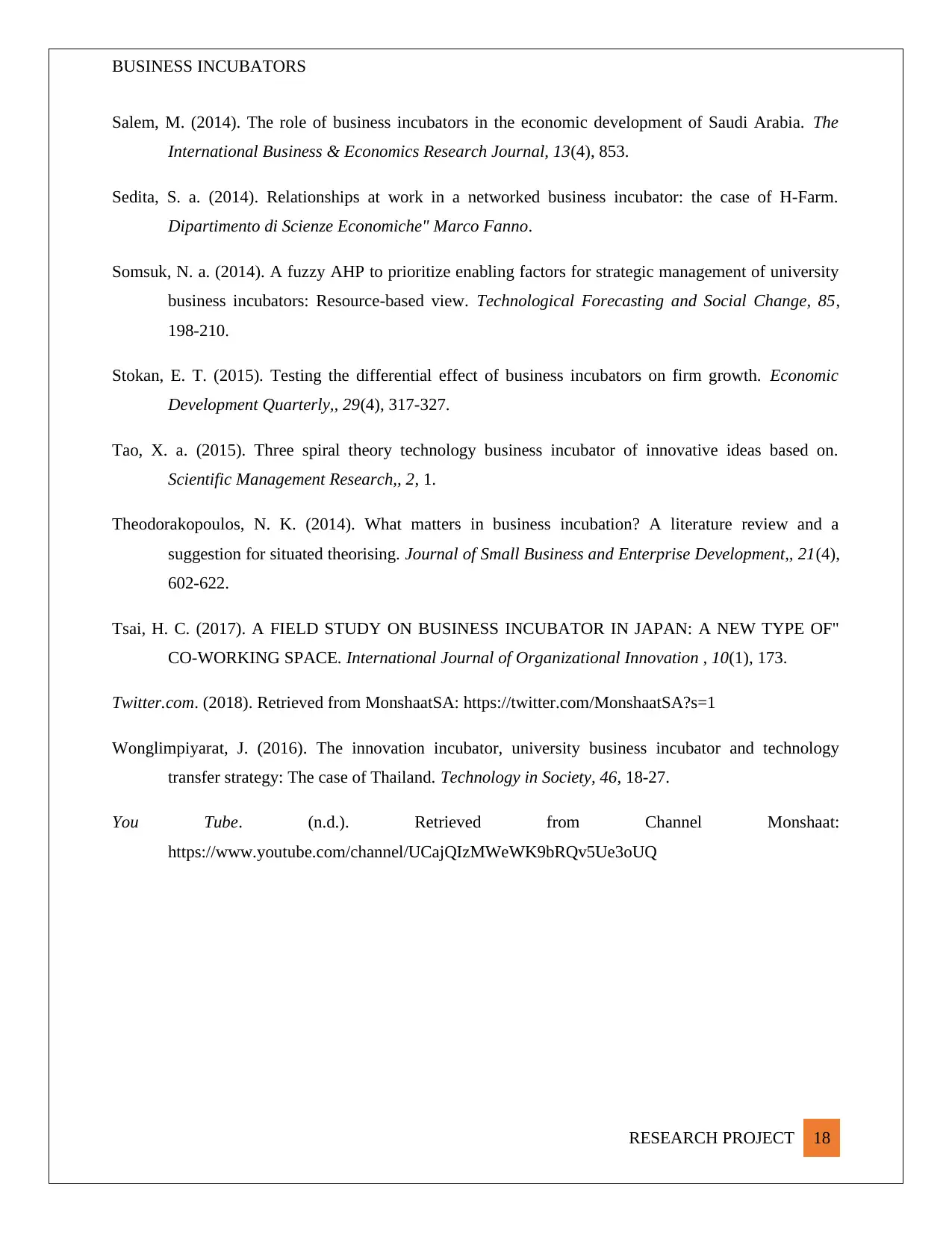
BUSINESS INCUBATORS
Salem, M. (2014). The role of business incubators in the economic development of Saudi Arabia. The
International Business & Economics Research Journal, 13(4), 853.
Sedita, S. a. (2014). Relationships at work in a networked business incubator: the case of H-Farm.
Dipartimento di Scienze Economiche" Marco Fanno.
Somsuk, N. a. (2014). A fuzzy AHP to prioritize enabling factors for strategic management of university
business incubators: Resource-based view. Technological Forecasting and Social Change, 85,
198-210.
Stokan, E. T. (2015). Testing the differential effect of business incubators on firm growth. Economic
Development Quarterly,, 29(4), 317-327.
Tao, X. a. (2015). Three spiral theory technology business incubator of innovative ideas based on.
Scientific Management Research,, 2, 1.
Theodorakopoulos, N. K. (2014). What matters in business incubation? A literature review and a
suggestion for situated theorising. Journal of Small Business and Enterprise Development,, 21(4),
602-622.
Tsai, H. C. (2017). A FIELD STUDY ON BUSINESS INCUBATOR IN JAPAN: A NEW TYPE OF"
CO-WORKING SPACE. International Journal of Organizational Innovation , 10(1), 173.
Twitter.com. (2018). Retrieved from MonshaatSA: https://twitter.com/MonshaatSA?s=1
Wonglimpiyarat, J. (2016). The innovation incubator, university business incubator and technology
transfer strategy: The case of Thailand. Technology in Society, 46, 18-27.
You Tube. (n.d.). Retrieved from Channel Monshaat:
https://www.youtube.com/channel/UCajQIzMWeWK9bRQv5Ue3oUQ
RESEARCH PROJECT 18
Salem, M. (2014). The role of business incubators in the economic development of Saudi Arabia. The
International Business & Economics Research Journal, 13(4), 853.
Sedita, S. a. (2014). Relationships at work in a networked business incubator: the case of H-Farm.
Dipartimento di Scienze Economiche" Marco Fanno.
Somsuk, N. a. (2014). A fuzzy AHP to prioritize enabling factors for strategic management of university
business incubators: Resource-based view. Technological Forecasting and Social Change, 85,
198-210.
Stokan, E. T. (2015). Testing the differential effect of business incubators on firm growth. Economic
Development Quarterly,, 29(4), 317-327.
Tao, X. a. (2015). Three spiral theory technology business incubator of innovative ideas based on.
Scientific Management Research,, 2, 1.
Theodorakopoulos, N. K. (2014). What matters in business incubation? A literature review and a
suggestion for situated theorising. Journal of Small Business and Enterprise Development,, 21(4),
602-622.
Tsai, H. C. (2017). A FIELD STUDY ON BUSINESS INCUBATOR IN JAPAN: A NEW TYPE OF"
CO-WORKING SPACE. International Journal of Organizational Innovation , 10(1), 173.
Twitter.com. (2018). Retrieved from MonshaatSA: https://twitter.com/MonshaatSA?s=1
Wonglimpiyarat, J. (2016). The innovation incubator, university business incubator and technology
transfer strategy: The case of Thailand. Technology in Society, 46, 18-27.
You Tube. (n.d.). Retrieved from Channel Monshaat:
https://www.youtube.com/channel/UCajQIzMWeWK9bRQv5Ue3oUQ
RESEARCH PROJECT 18
1 out of 18
Your All-in-One AI-Powered Toolkit for Academic Success.
+13062052269
info@desklib.com
Available 24*7 on WhatsApp / Email
![[object Object]](/_next/static/media/star-bottom.7253800d.svg)
Unlock your academic potential
© 2024 | Zucol Services PVT LTD | All rights reserved.